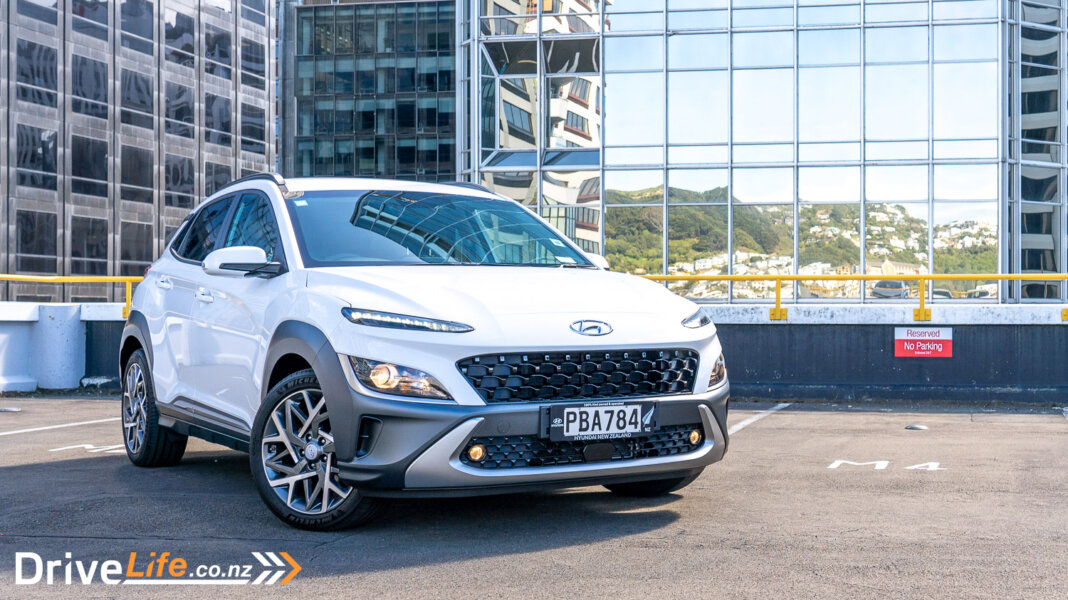We’ve been fans of the Hyundai Kona for a while now, here at DriveLife. It’s a competent small SUV that comes as a petrol-powered model, or a full EV. But the Kona EV is double the cost of the petrol model, putting it well out of reach of many Kona buyers.
Hyundai has decided to bridge the gap with a petrol-hybrid version of the Kona, to appeal to those who’d like to save fuel/cut emissions, and start weaning themselves off pure internal combustion engines (ICE).
But does it really save fuel? Full road tests with the Suzuki Swift Hybrid and the Subaru Forester Hybrid showed us that not all hybrids are equal.
We spent a week and 700km in the 2022 Hyundai Kona Hybrid Elite to answer that very question.
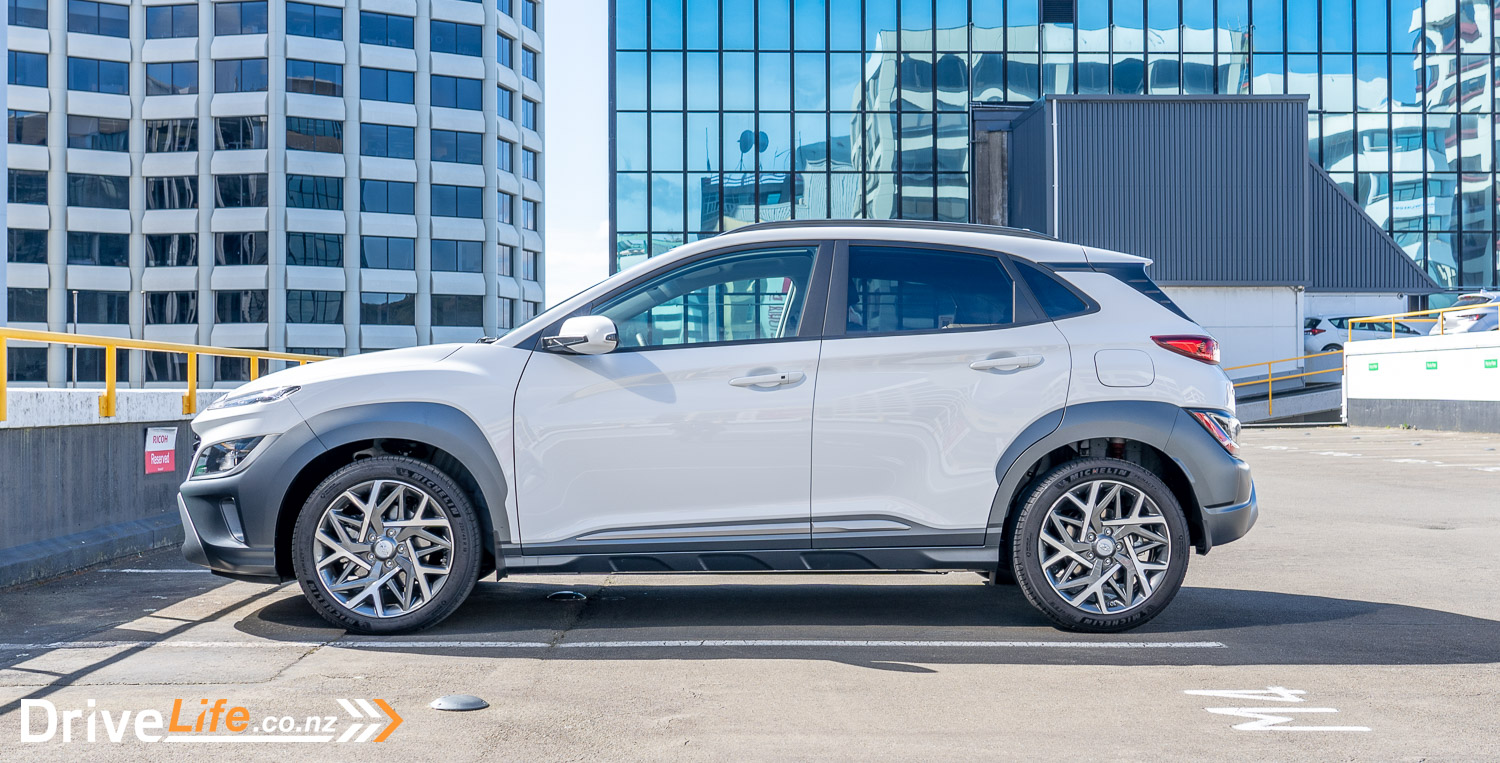
What We Like and Dislike About The 2022 Hyundai Kona Hybrid Elite
| What we like | What we don’t like |
| Overall driveability Ease of use (hybrid) Relatively refined Ergonomics are pretty much spot-on So easy to live with Equipment levels Ride quality | More road and tyre noise than we’d like to hear $15,000 premium over non-hybrid Kona Elite Not saving a lot of fuel The interior is a little bland |
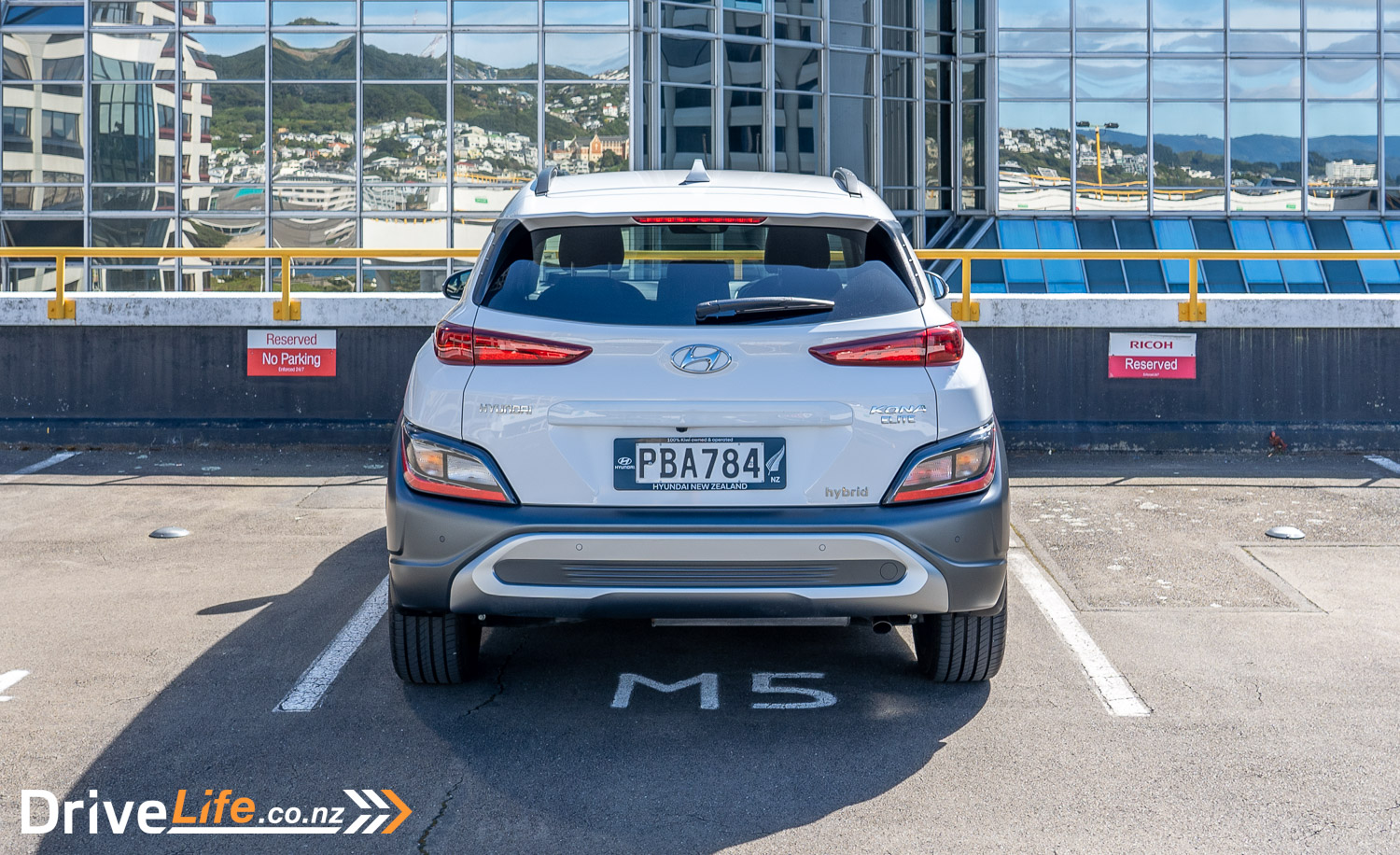
What’s In The 2022 Hyundai Kona Hybrid Range?
New Zealand sees two models of the Kona Hybrid, the $49,990 Kona Hybrid and the $54,990 Kona Hybrid Elite.
Mechanically the models are identical and are separated by add-on features only. The drivetrain is a 1.6-litre, 4-cylinder petrol engine mated to a 32kW/170Nm electric motor. The petrol engine has an output of 77kW of power and 147Nm of torque, and Hyundai claims the combined output is 104kW/265Nm. Note that this is not a plug-in hybrid; the hybrid battery is charged up while you are driving or going down a hill, so there is nothing to be done with plugging the car in to charge. Some manufacturers call this a ‘self-charging’ hybrid. The drive battery is 1.56kWh in size.
The transmission is a 6-speed dual-clutch automatic (DCT) transmission, and the Kona Hybrid is front-wheel drive only.
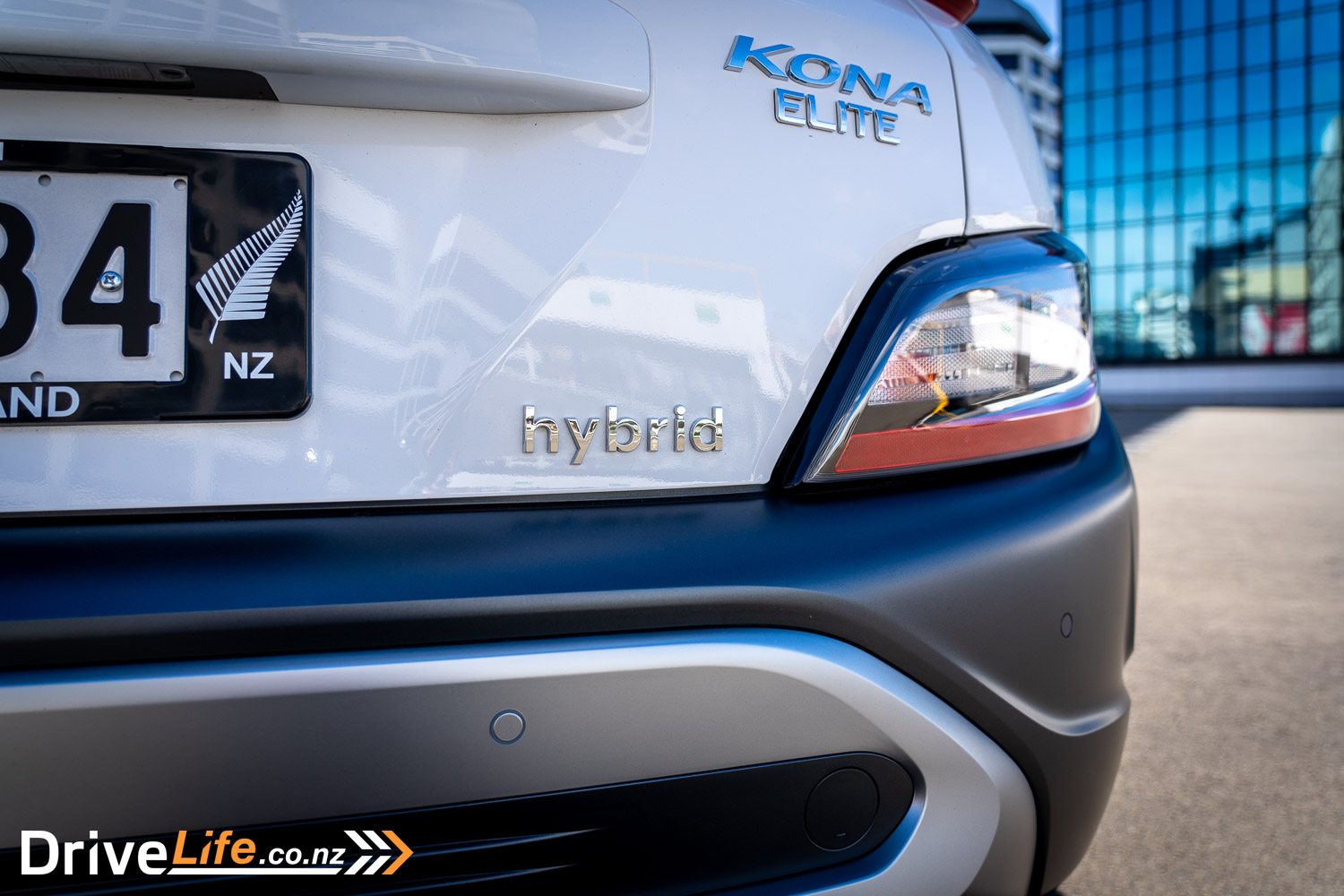
2022 Hyundai Kona Hybrid Standard Equipment Highlights
Safety Features
- ABS braking with Electronic Brake-force Distribution (EBD)
- Brake Assist System (BAS)
- Electronic Stability Control (ESC)
- Traction Control System (TCS)
- Vehicle Stability Management (VSM)
- Blind-spot Collision Avoidance assist (BCA)
- Rear Cross-traffic Collision Avoidance assist (RCCA)
- Forward Collision-Avoidance assist (FCA) – car, pedestrian & cyclist
- Lane Keeping Assist (LKA)
- Smart Cruise Control (SCC) with stop & go
- 6 Airbags (Dual Front, Side, Curtain Airbag)
- Front seatbelt pretensioners and load limiters
- 3-point tether child seat anchor points
- 2 x ISOFIX child seat anchor points
- Height adjustable seatbelts (front)
- 3-point lap diagonal (ELR) seatbelts
- Child safety rear door locks
- Automatic dusk sensing headlights
- Rain sensing wiper system
- Rear park assist system
- Reversing camera
- First aid kit
Exterior Features
- Electrically adjustable side mirrors
- Electric folding side mirrors
- Heated side mirrors
- LED Daytime Running Lights (DRLs)
- Rear spoiler with high-mounted LED stop light
- Privacy & solar glass
- Mud guards
Interior Features
- Cloth interior trim
- Leather steering wheel and gearshift trim
- Height adjustable passenger seat
- Power windows
- Wireless smartphone charging
- Rear seat 60:40 split folding function
- Rear seatback pockets
Security
- Keyless entry with anti-theft alarm
- Engine immobiliser
- Hyundai Active Locking Operation (HALO) including speed sensing auto door locking
Comfort and Convenience
- 8″ touch screen audio system
- Apple CarPlay & Android Auto compatibility
- 4 speakers and 2 tweeters
- Bluetooth handsfree phone system
- Steering wheel-mounted audio and cruise controls
- Automatic climate control air-conditioning with pollen filter
- Automatic windscreen defog
- Trip computer including distance to empty, average fuel consumption and outside temperature display
- 10.25″ colour full TFT driver display
- Illuminated vanity mirror in driver and front passenger sun visors
Upgrading to the Elite model adds:
- Electro Chromatic rear-view Mirror (ECM)
- Full leather interior trim
- Driver seat 8-way electric sliding, reclining, height and lumber adjustable
- Passenger seat 6-way electric sliding, reclining and height adjustable
- Heated front seats
- Keyless entry and start
The Kona Hybrid is eligible for a $3418 Clean Car rebate.
Colour options for this model are:
- Atlas White
- Galactic Grey
- Cyber Grey
- Dive in Jeju
- Dark Knight
- Ignite Flame
- Phantom Black
For a full list of specs and options available for the Hyundai Kona Hybrid, head on over to the Hyundai New Zealand website.
How Does The 2022 Hyundai Kona Hybrid Elite Compare To Its Competition?
All prices below exclude the refund or additional cost of the New Zealand Clean Car Programme.
| Make/ Model | Engine | Power/ Torque kW/Nm (combined) | Seats | Fuel L/100km | Boot Space litres | Price (excl CCP) |
| Hyundai Kona Hybrid Elite | 1.6-litre, 4-cylinder petrol-hybrid | 104/265 | 5 | 4.4 | 374 | $54,990 |
| Kia Niro HEV Water | 1.6-litre, 4-cylinder petrol-hybrid | 104/26 | 5 | 4.4 | 451 | $53,990 |
| Mazda MX-30 Hybrid | 2.0-litre, 4-cylinder petrol-hybrid | 114/200 | 5 | 6.4 | 370 | $46,790 |
| Toyota Yaris Cross Limited Hybrid | 1.5-litre, 3-cylinder petrol-hybrid | 85/120 | 5 | 3.8 | 390 | $43,290 |
| Honda Jazz e:HEV Luxe | 1.5-litre, 4-cylinder petrol-hybrid | NA/253 | 5 | 2.8 | 304 | $35,000 |
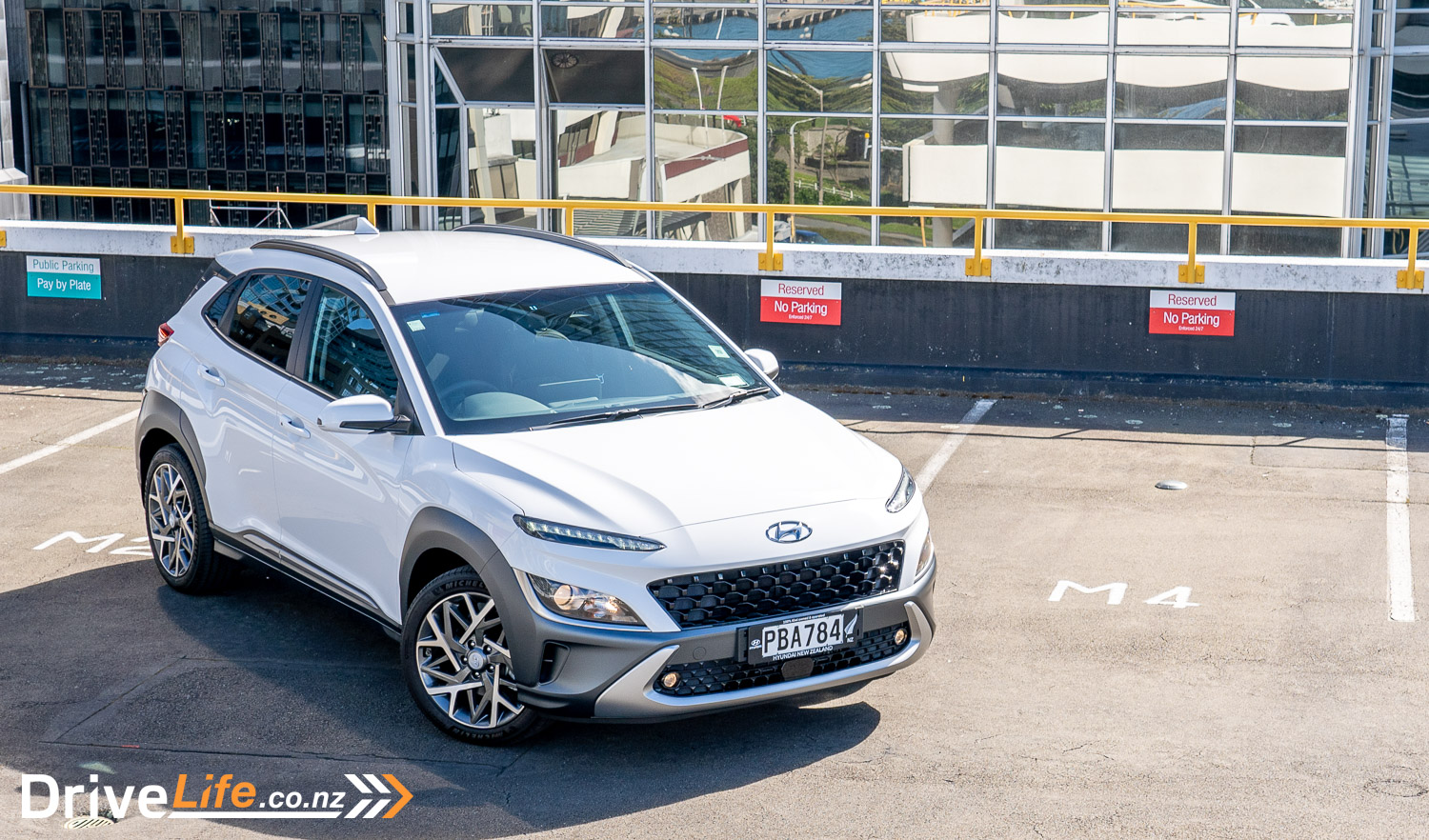
First Impressions Of The 2022 Hyundai Kona Hybrid Elite
The Series II Kona is a much better-looking car than the Series I. Not that the first generation was a bad looker – far from it – but the changes applied for the Series II have done a great job of a nip and tuck.
Since this is a hybrid, you might expect some wacky grille or weird wheels. Not so. The whole car looks the same as the ICE Kona, bar a small hybrid badge on the boot. Nicely done, Hyundai.
Finished in Atlas White, our test car was bright and funky, even during the mostly wet and dull days over our test period. The rear of the car can feel a little busy, but overall it’s a pleasing design, and the front end looks superb.
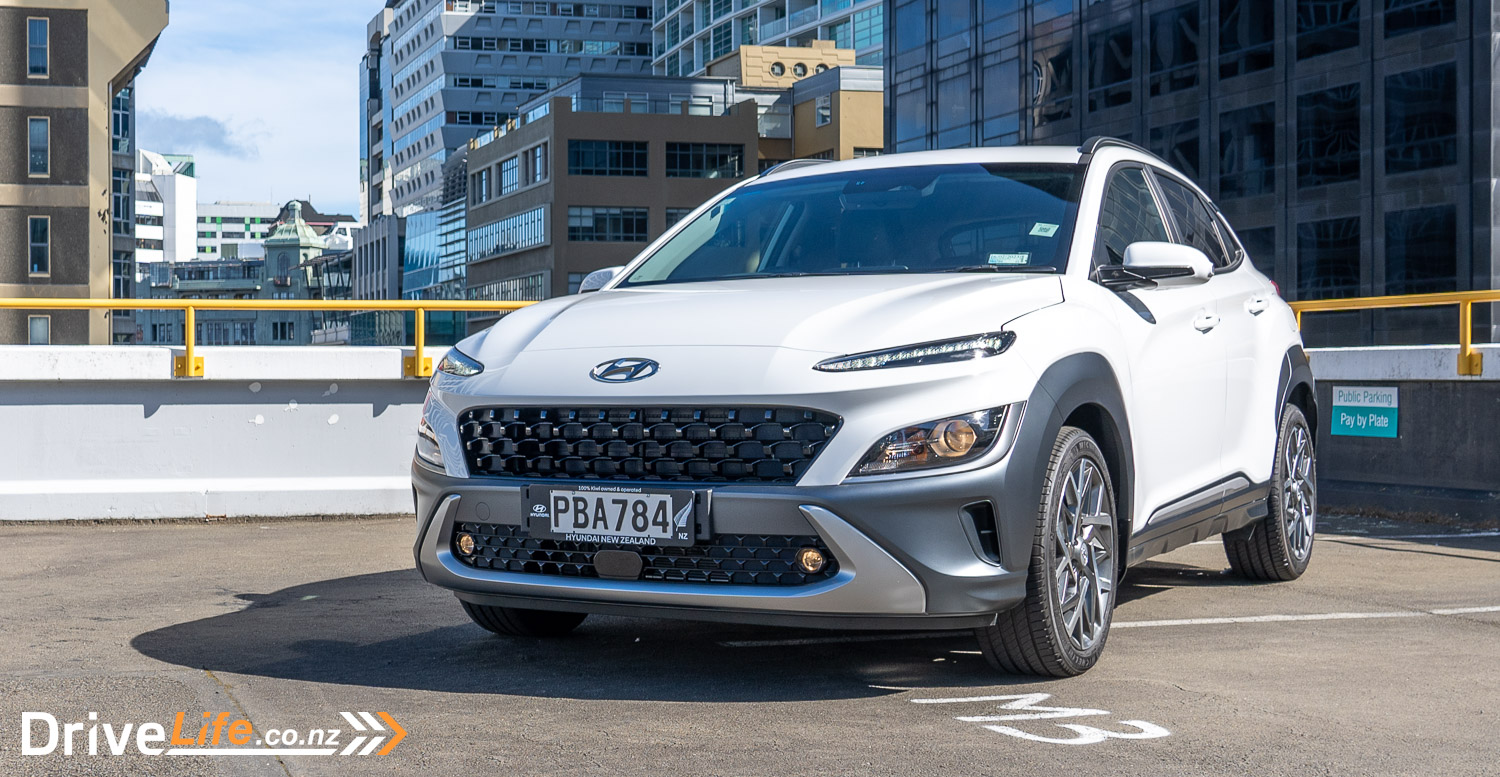
What’s The Interior Like In The 2022 Hyundai Kona Hybrid Elite?
I won’t go on too much about the interior of the Kona Hybrid Elite, as it’s almost identical to the ICE Kona Elite model that Rob tested last year. You can read Rob’s review here.
Regardless, there’s quite a bit of deja vu going on in the cabin, both good and not-so-good. As is standard with any current Hyundai, the build quality is excellent, and all controls feel great to use and touch.
On the ‘but’ side of things, there aren’t a lot of different materials used so it can feel quite bland. This is where MG blew me away with our recent test of the new ZS EV; that new model has a great interior, and yet it’s only slightly more expensive than our test car.
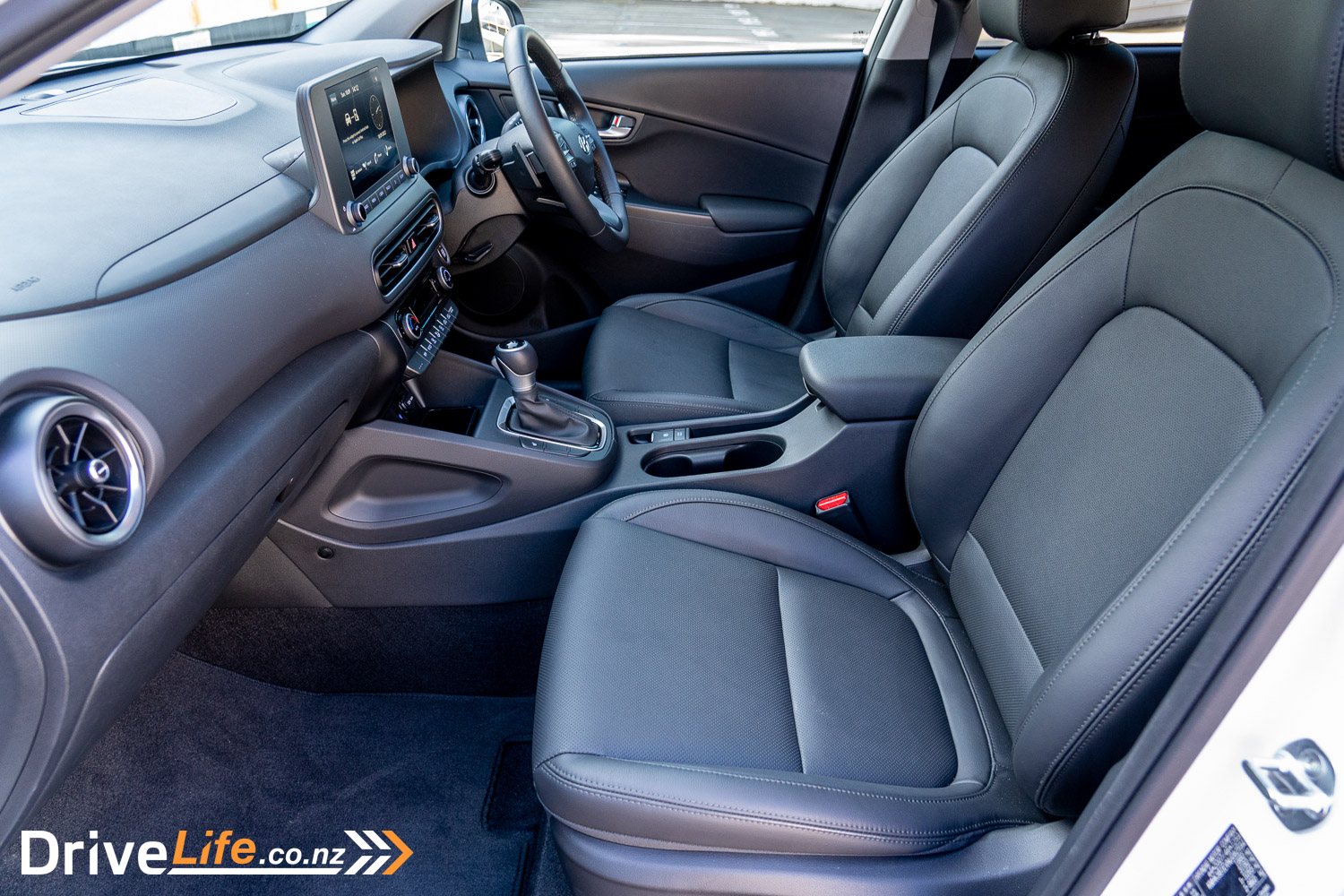
But the Kona Hybrid Elite is still a great place to spend a week commuting. I love having wireless charging in a car – just throw your phone on the pad, and that’s it. Like other Hyundai models, the Kona Hybrid Elite’s charging pad has a fan to help keep your phone cool while it charges.
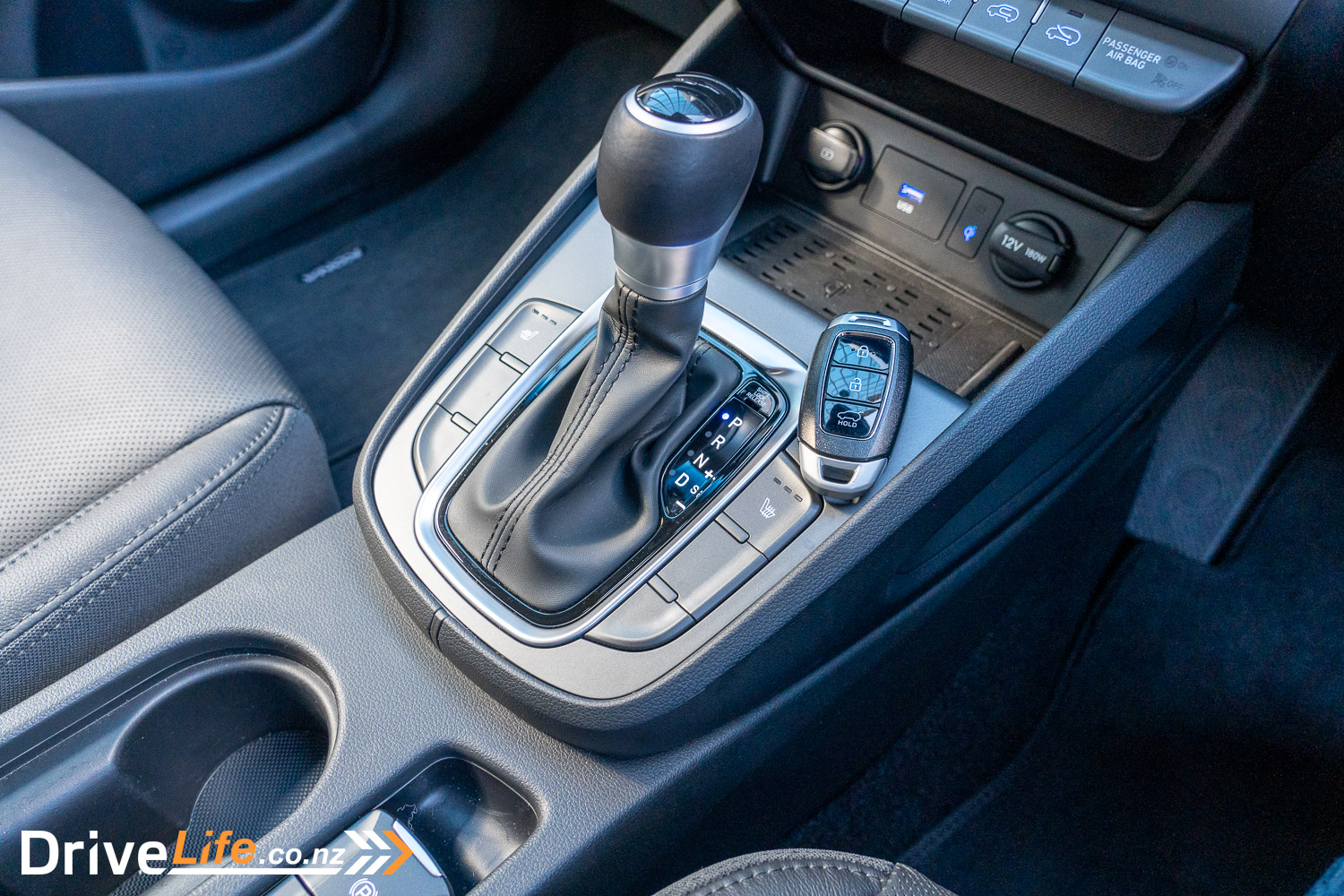
There is a 12-volt socket at the front of the centre console, along with two USB-A ports. There’s an almost-hidden shelf just above the USB ports; I could see some people selling their Kona Hybrid and forgetting to check this storage spot – it’s pretty well tucked away, but still handy. Rear seat passengers get a single USB-A port to charge their device.
One of the changes from the ICE model is the removal of the spare wheel in the boot – there’s only a pump there now. The boot itself is pretty usable in size, and with the removal of the spare, there’s also space under the floor for more stuff.
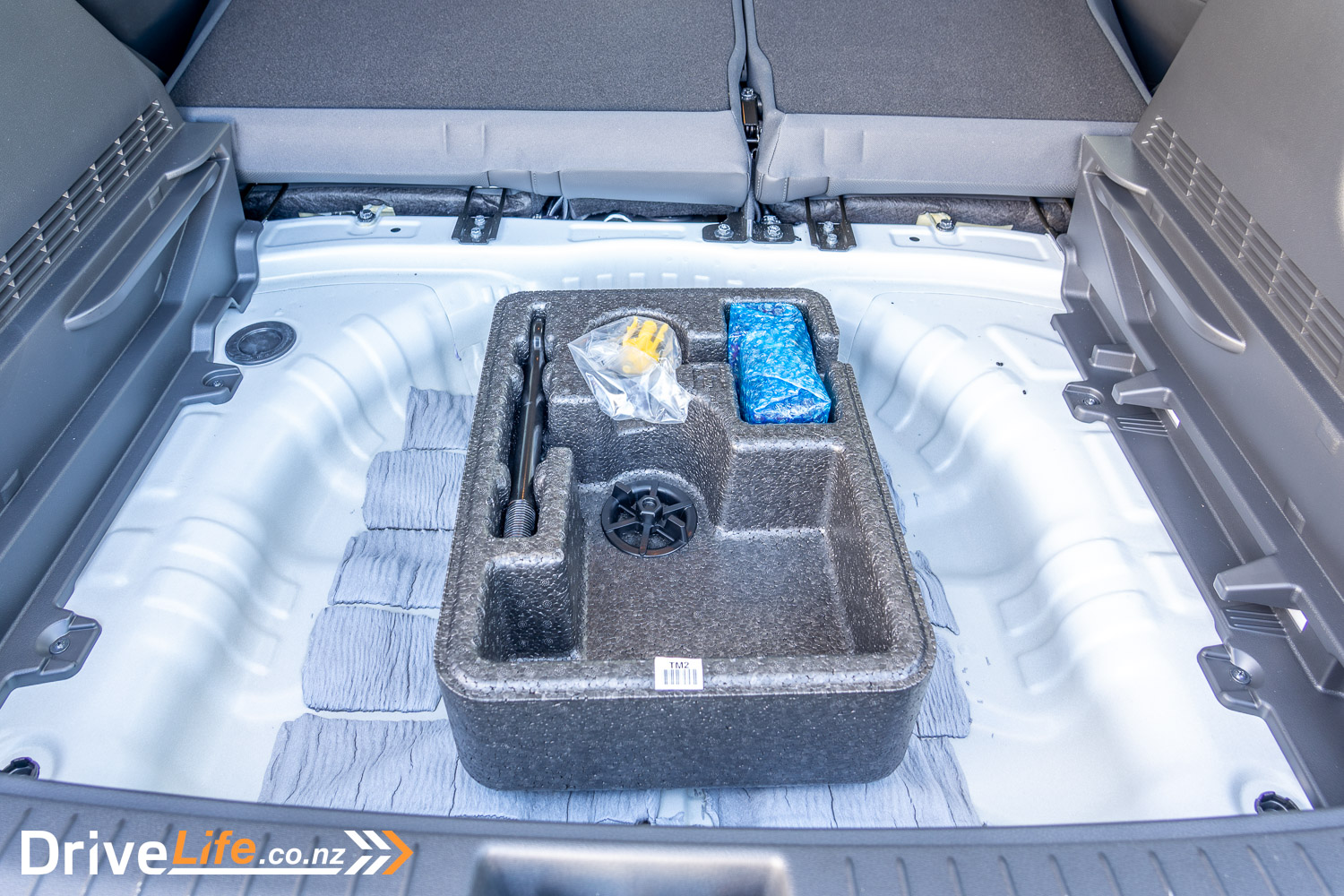
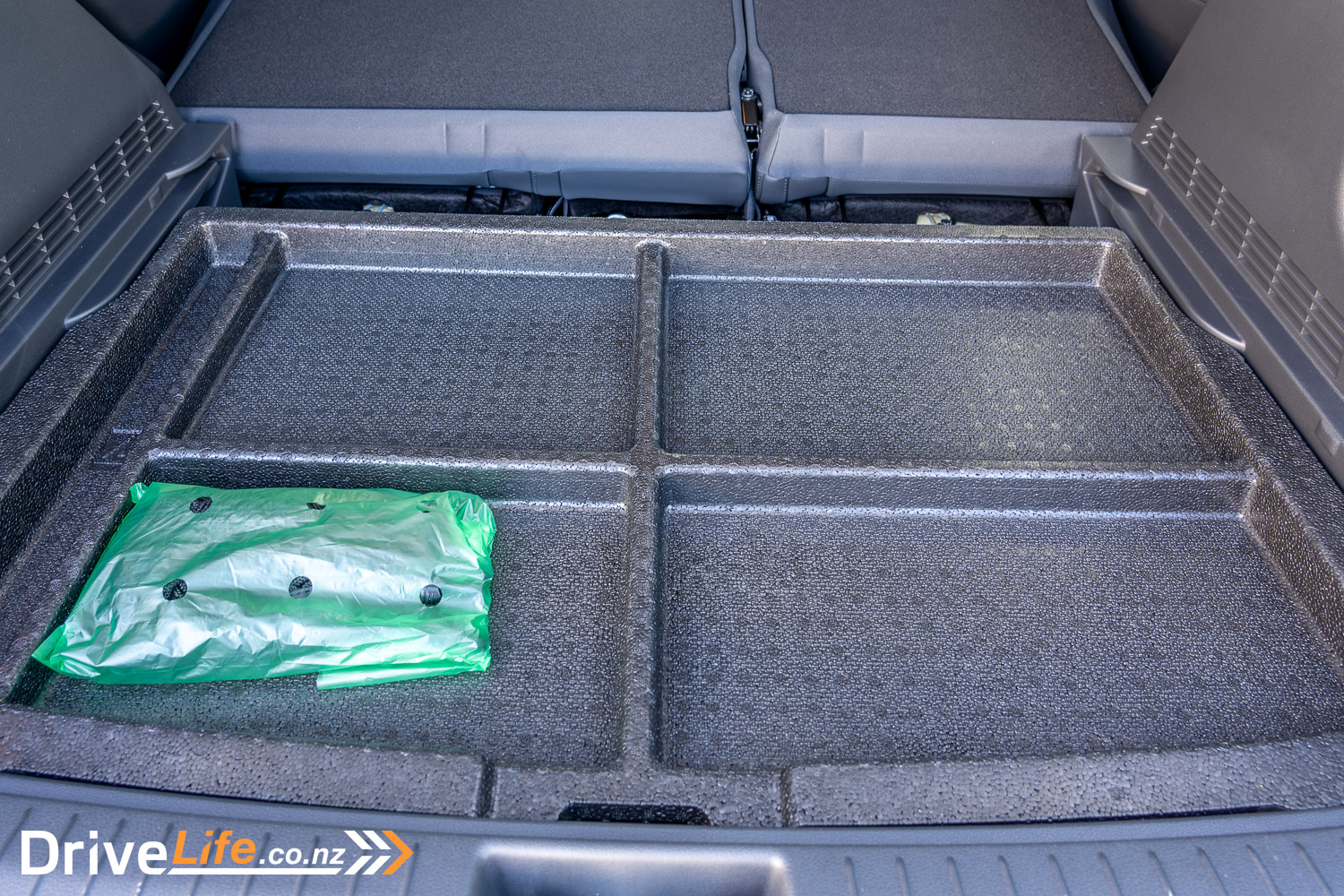
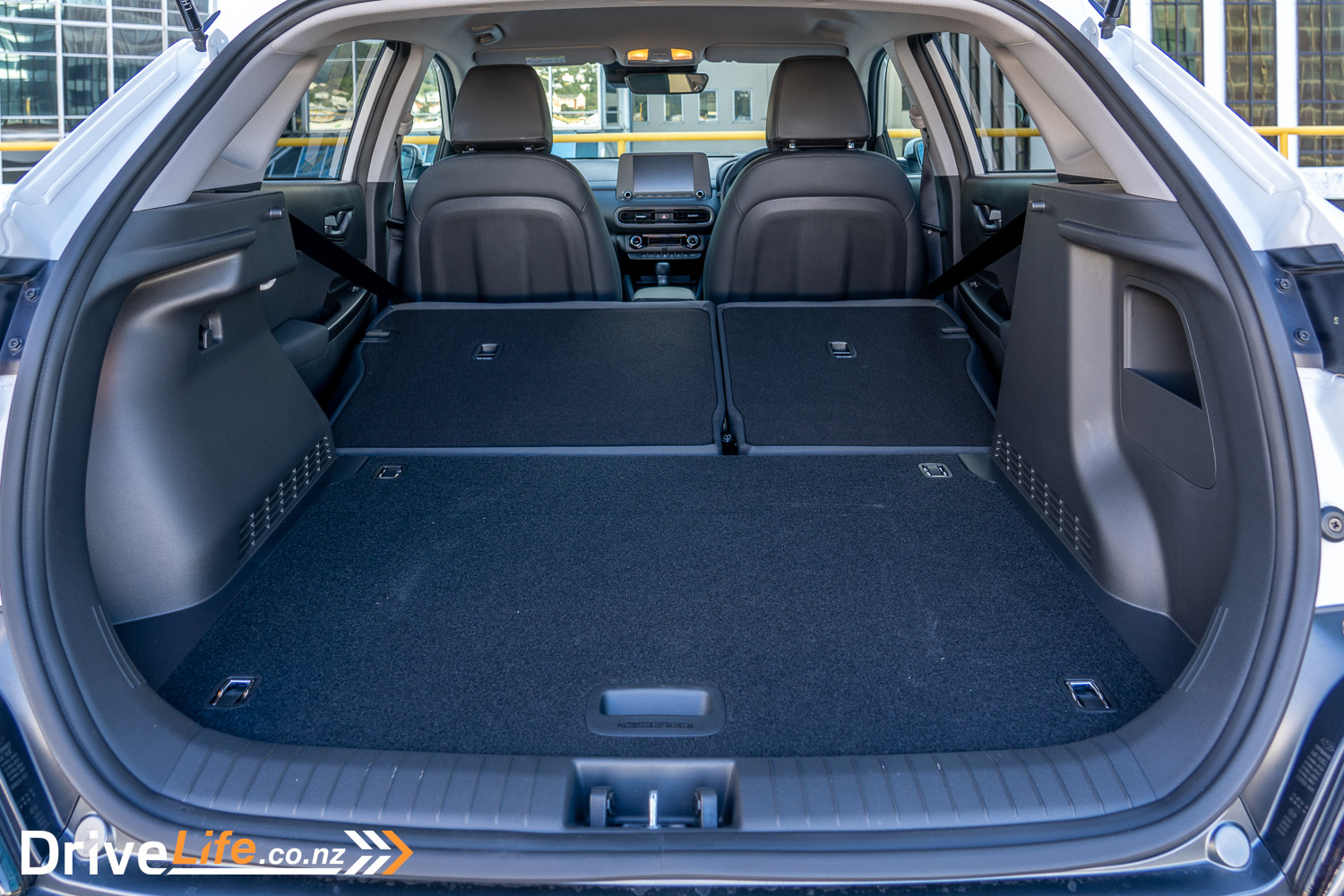
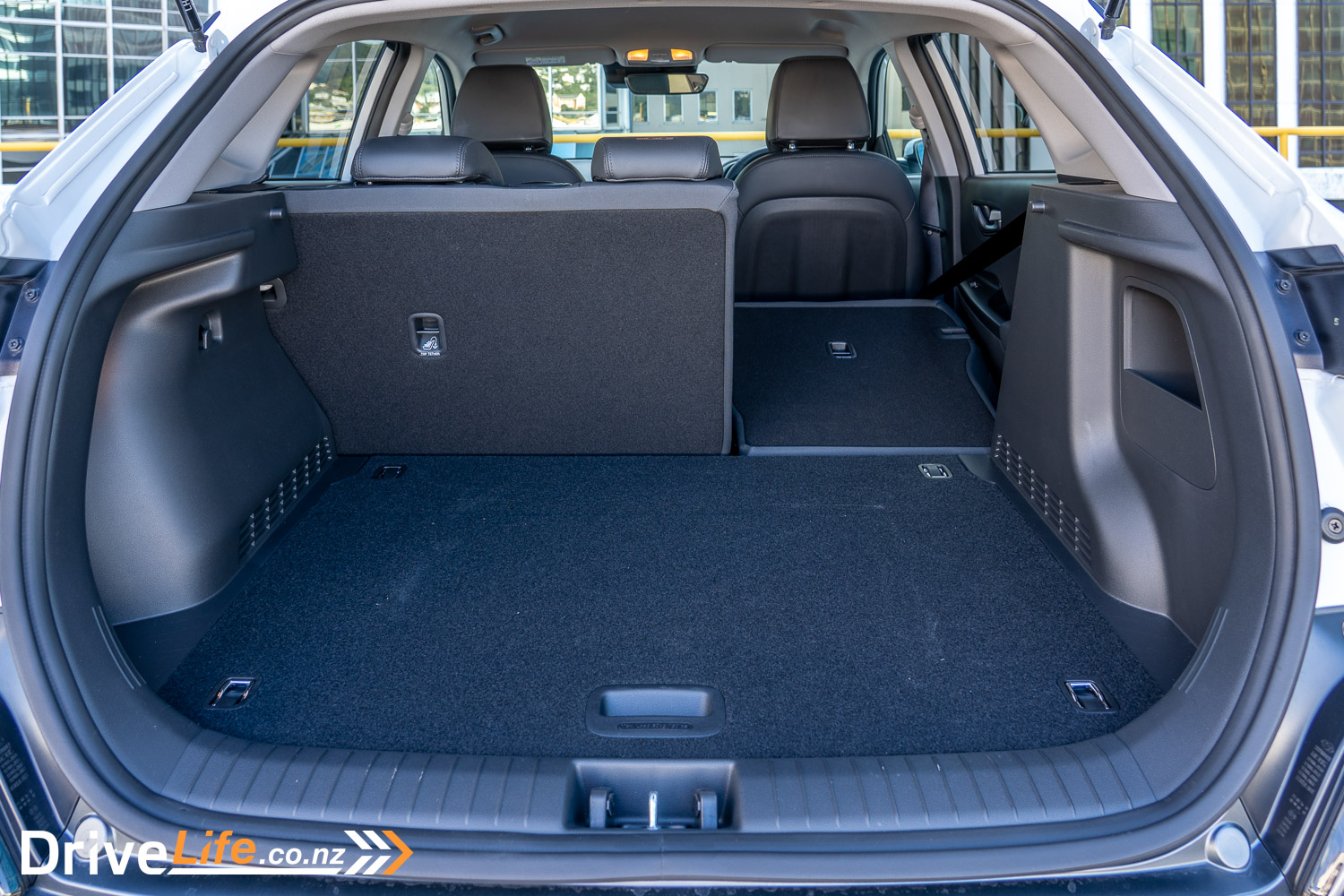
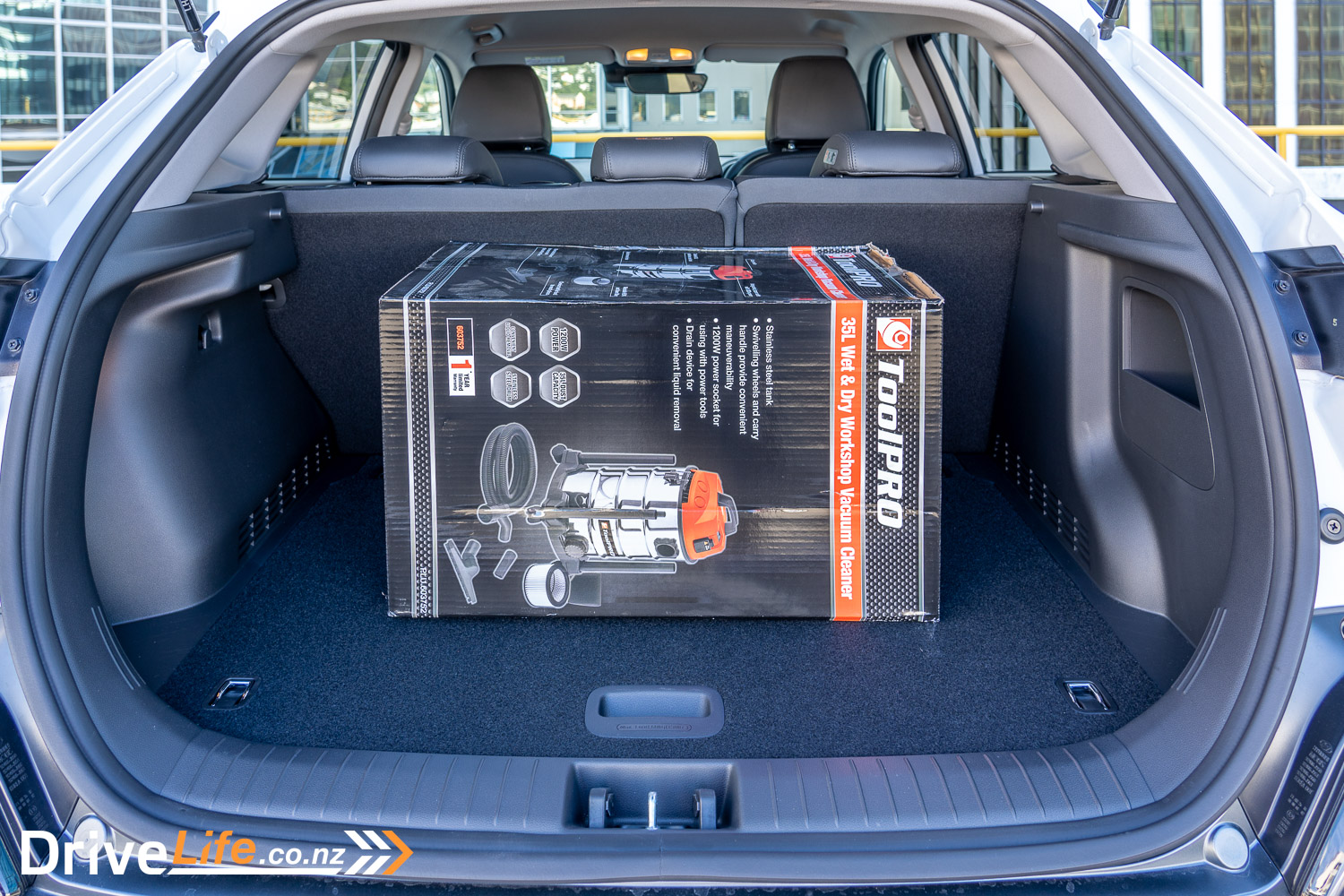
What’s The 2022 Hyundai Kona Hybrid Elite Like To Drive?
Picking up the Kona Hybrid, I saw the expected range on a tank of gas: 745Km. Challenge accepted! With a 120Km daily commute for the next five days, we’d see just how close to that 745Km I could get.
While most manufacturers make hybrids a little more complicated than their ICE equivalents, not the Kona Hybrid. Hyundai has done away with any sort of need to push buttons or do anything, so you just get in and drive. I expect this could win buyers over for its sheer simplicity.
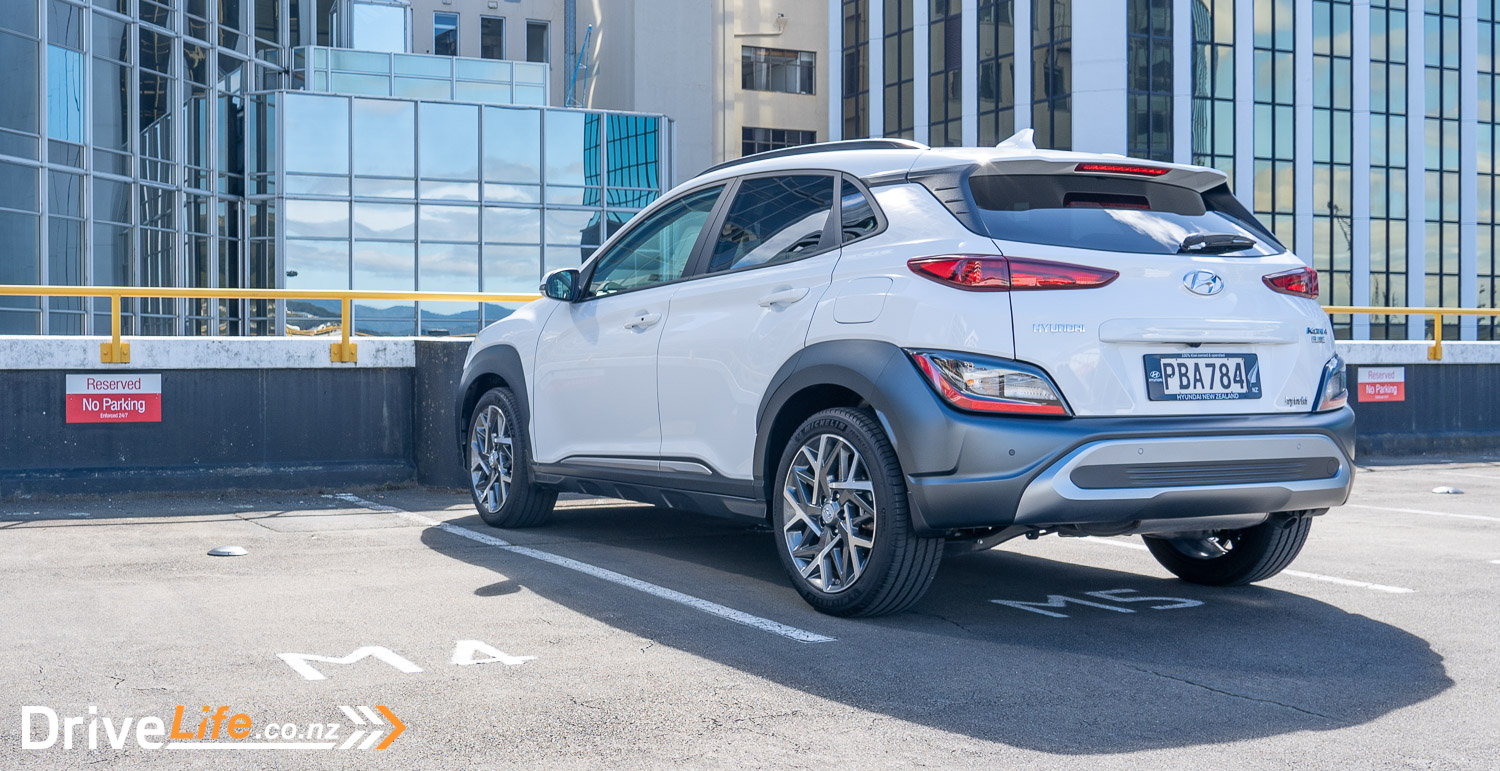
There isn’t even a drive mode button like there is on the ICE Kona Elite. The only option you have to change anything is to move the gear lever to the right for Sport mode. At this point, the gauges go through an animated change to red (yes, it’s a little geeky but quite cool as well) and the car becomes more responsive. Shifting the level back to the left moves the car back into Eco mode, which is its standard mode.
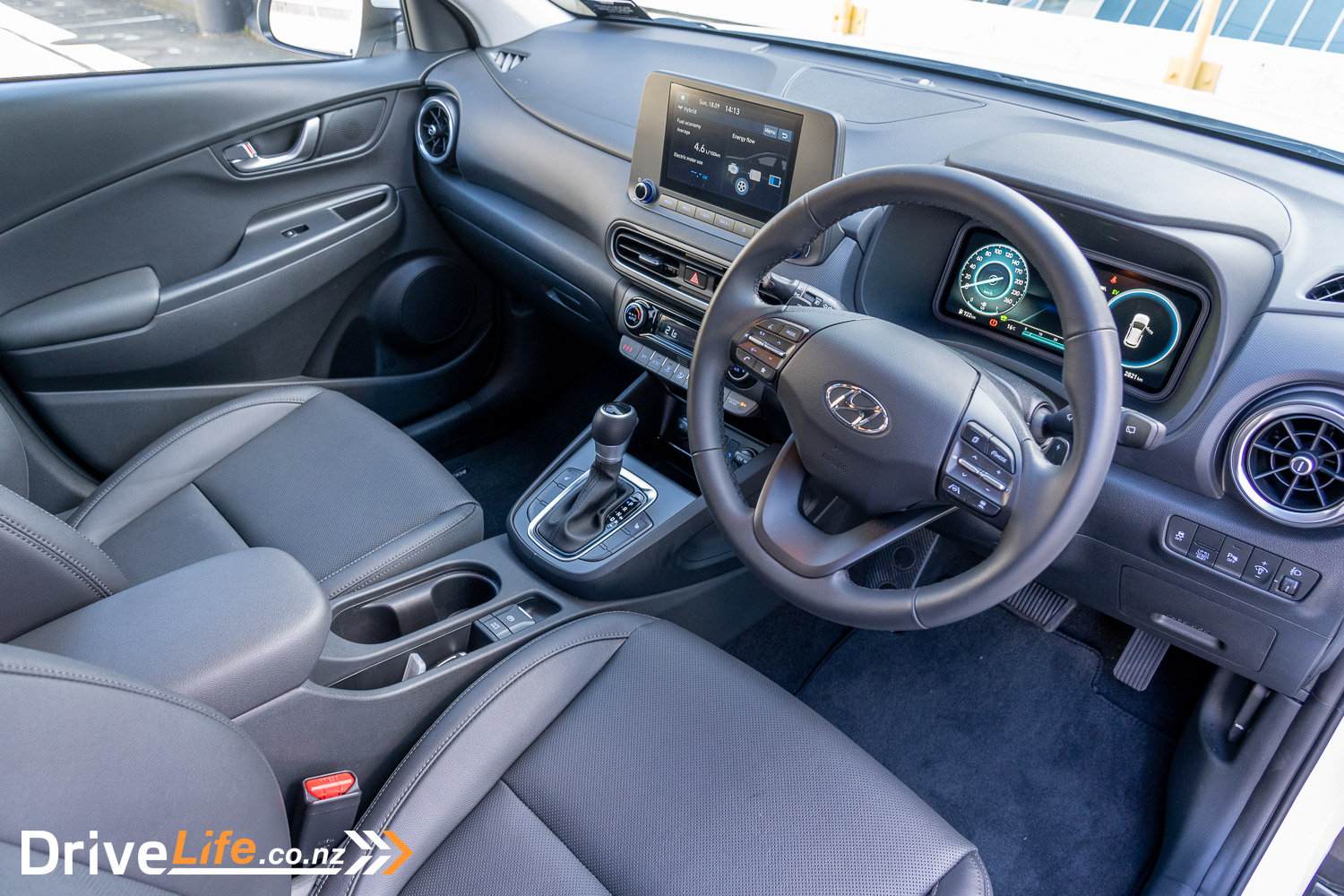
Okay, you do get paddles to adjust your brake regeneration (regen) level but you don’t have to use them. If you want a simple hybrid that is incredibly user-friendly, the Kona Hybrid is the car for you.
If you decide to use the paddles to adjust your regen (to gain extra battery charge), there are three levels. The first level is almost a coast mode, then the regen gets progressively stronger. At its highest level, it will stop the car down even the steepest of hills. While it’s not one-pedal driving, you can use those paddles to adjust your speed down a hill and avoid touching the brakes.
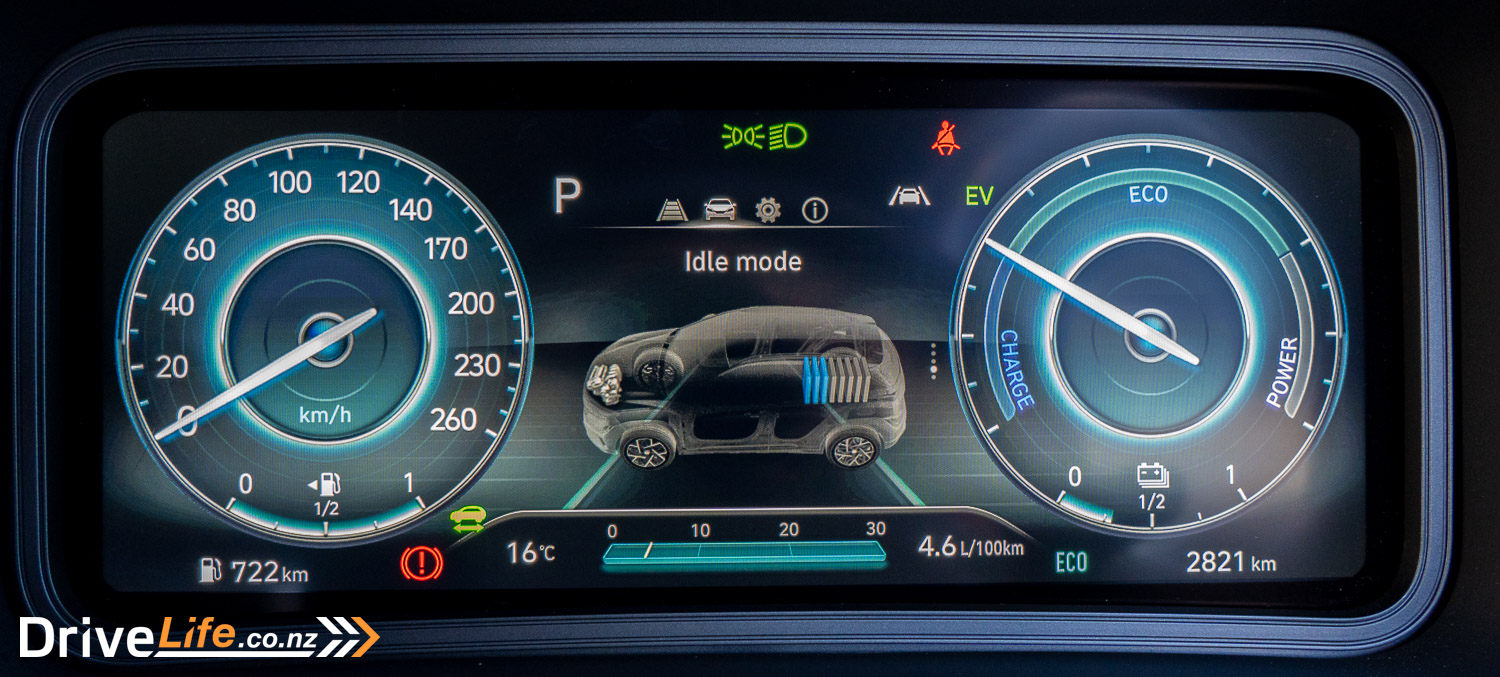
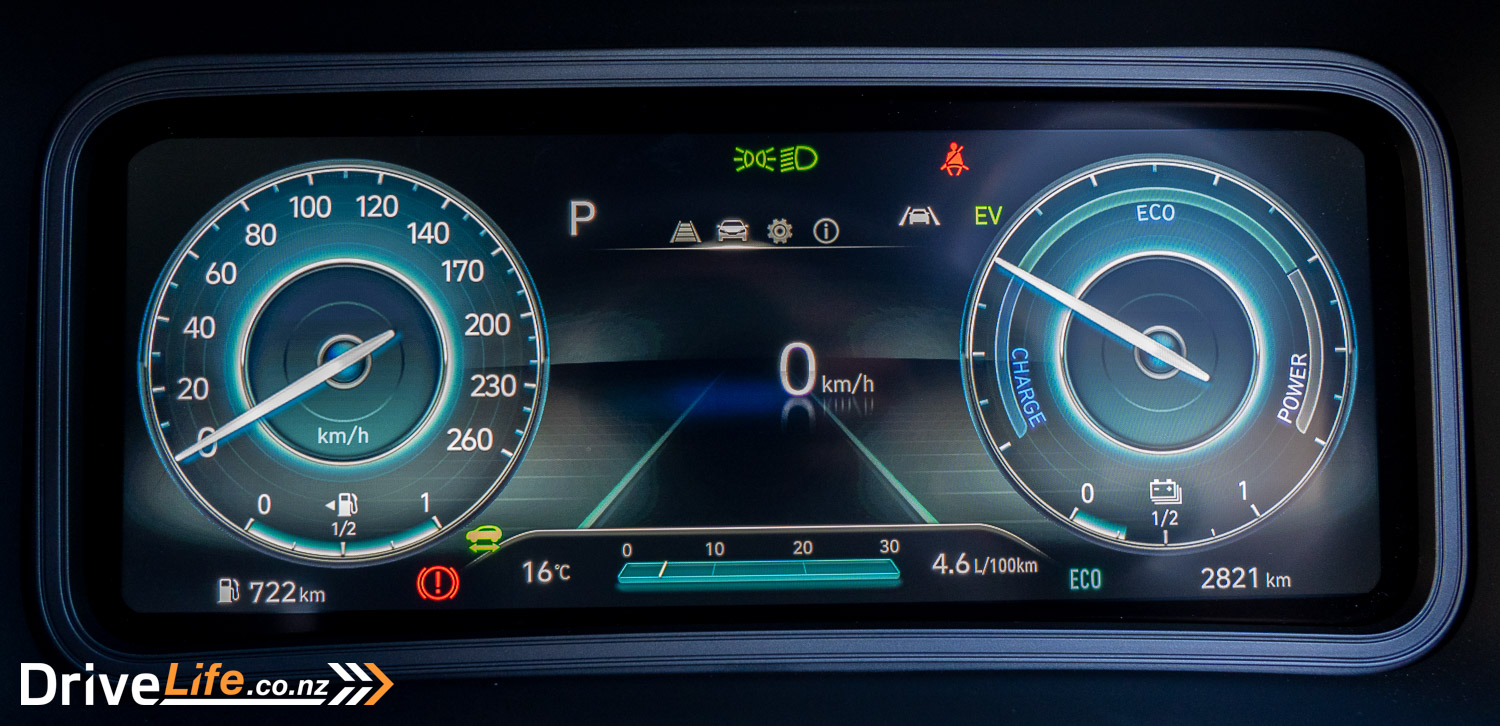
Performance overall is very good. With 265Nm of torque when you combine the outputs of the petrol engine and the electric motor, the Kona Hybrid will get up and boogie when you need it to. Sport mode will see the car with a far better response, and surprisingly good performance. It’s no rocketship, but Sport mode is very handy for passing slower traffic on the open road. In Sport mode, the steering wheel paddles change function to shift gears instead of brake regen.
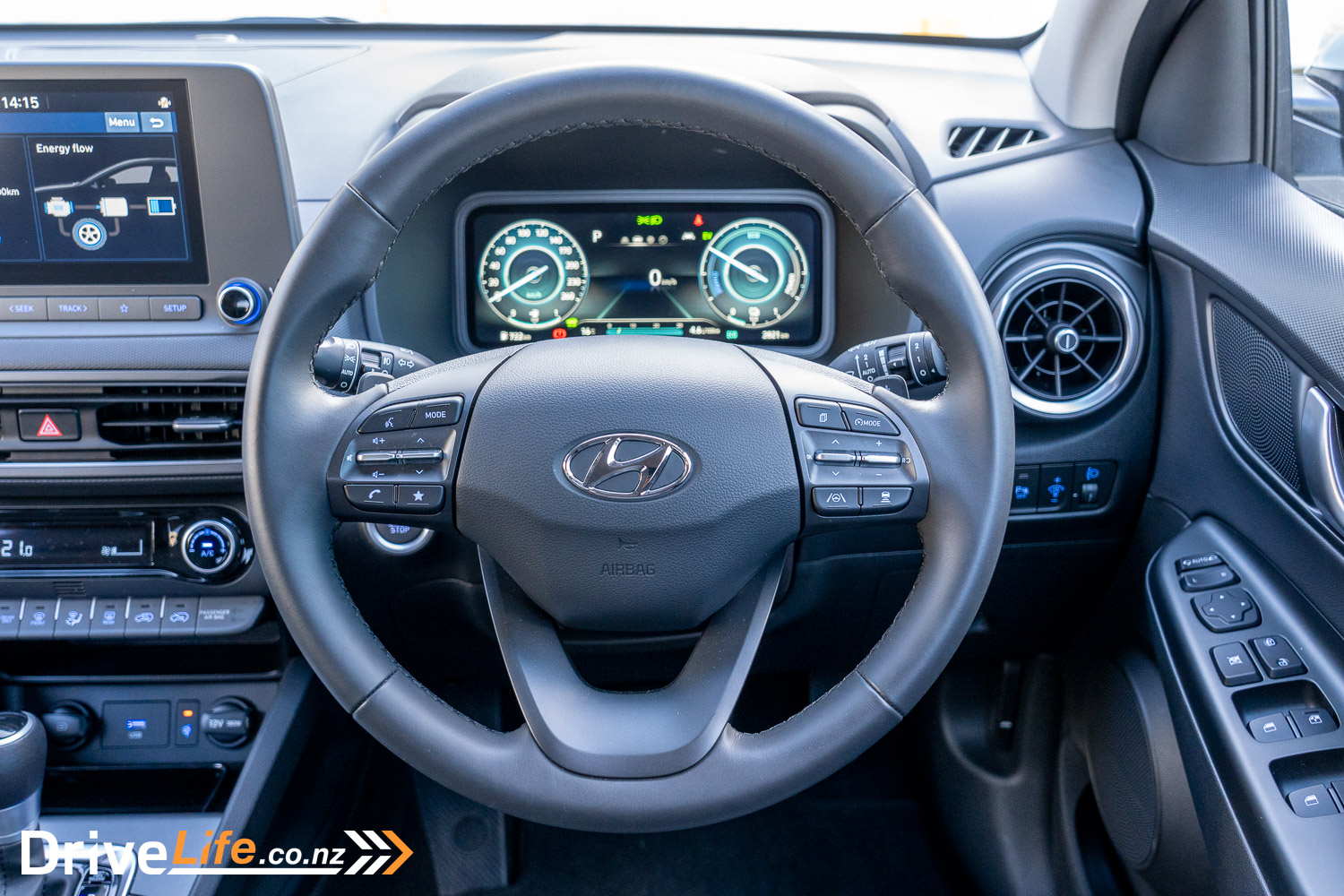
The main screen has a ‘Hybrid’ option on it to show you your fuel economy overall, and where the power is going to, or coming from. I had this screen on sometimes, but it’s not necessary; just let the Kona Hybrid manage it all for you and ignore it.
The actual use of the electric motor while driving is a bit of a mixed bag. At times on the motorway, only the electric motor would be operating, saving fuel. But around town, it doesn’t take much prodding of the accelerator to get the petrol engine to start, even with a near-full battery. Still, as mentioned – who cares? Just let the car do its thing and you get on with driving it.
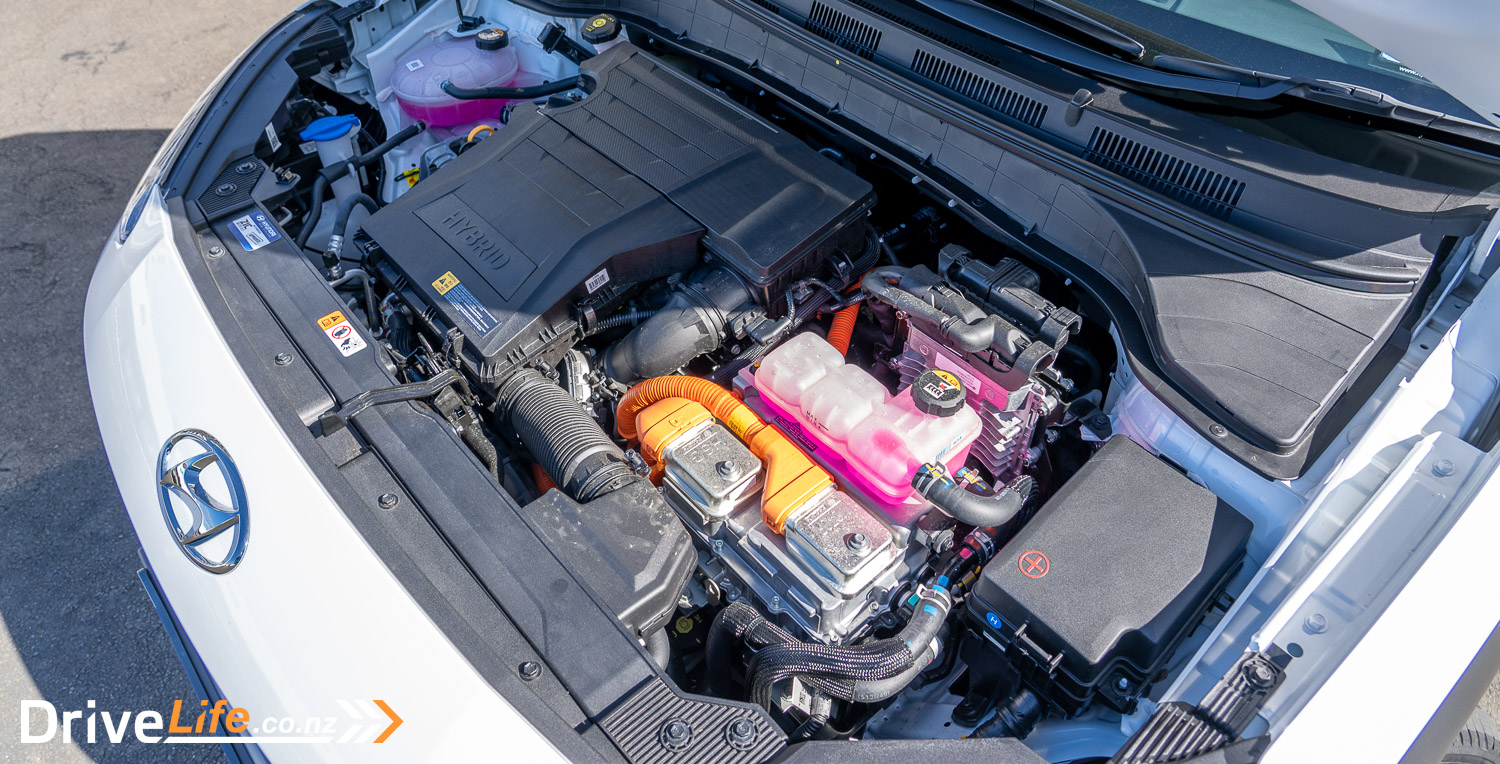
It was nice to see a “Driver Only” aircon button on the dash; we often see this on an EV and not in a hybrid, but since that daily commute was with me only in the car, this button should save some energy. You also get three-stage heated front seats in the Kona Hybrid Elite so, between that and the driver-only AC setting, you minimise your power consumption.
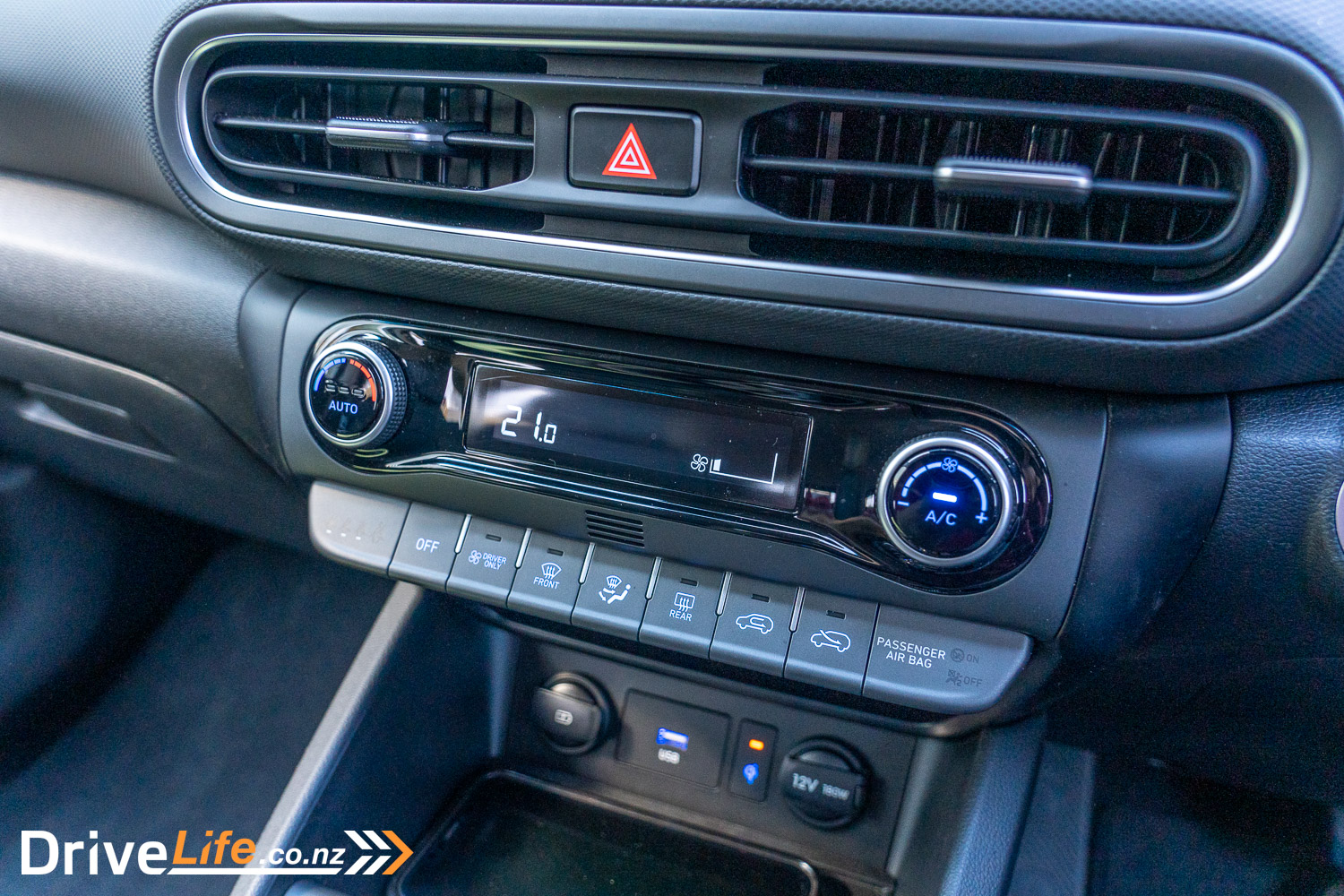
Travelling 120Km a day is a great test of so many things; not just fuel efficiency, but seat comfort, visibility, ease of use and other factors. The Kona Hybrid Elite scores well on most of these. The seat comfort is very good overall, with no aches or pains, although I’d like to see 4-way lumbar adjustment (currently it’s only a two-way).
With a beige headlining and pillars, the interior feels quite light and airy, while visibility is hampered by chunky A, B and C pillars. Backing out of my driveway, I really had to swing my head forward and backwards to see around those B pillars to make sure no pedestrians were walking past. You do get rear cross-traffic alert to help with making sure there are no cars or people coming while you reverse, and that was very much appreciated. On the move, there’s blind spot monitoring on the mirrors to help keep you safe.
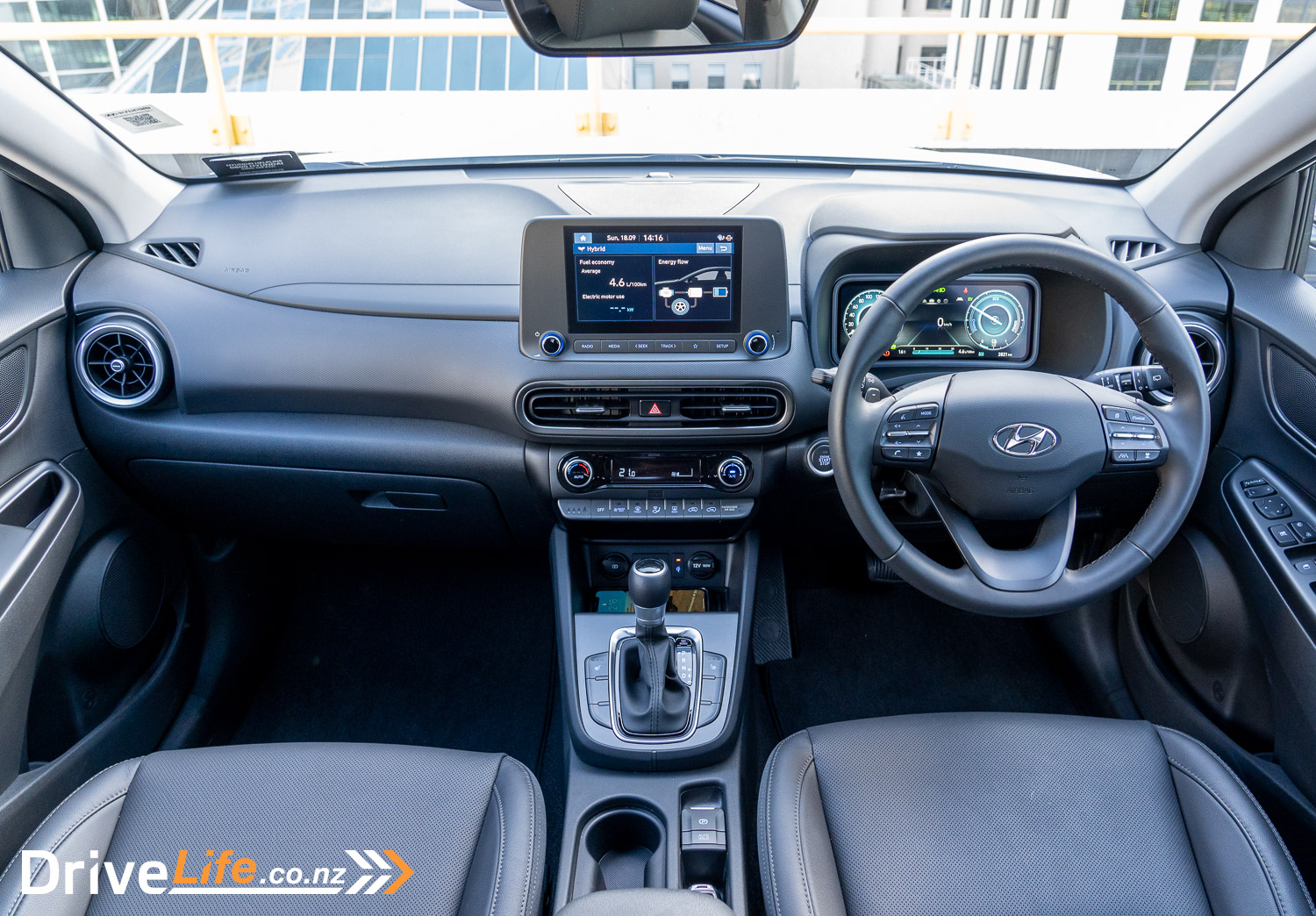
There is some wind noise from the A-pillar when travelling at 100Km/h, but it’s never too intrusive. Those Michelin Primacy tyres can get noisy too, especially on coarse-chip seal. I found this same issue recently with the MG ZS EV on the same tyres. Road noise is higher than I had expected it to be and while the petrol engine is generally reasonably quiet, it can get a little vocal up some steeper hills. This was particularly noticeable heading up to the saddle from the north side of Transmission Gully.
That’s pretty much it for the negative side of things on the Kona Hybrid. The steering wheel controls are unchanged and are perfect. Within minutes of familiarising myself with them, I rarely looked down again to see what button I was pushing. That’s a great sign of a perfect steering wheel setup.
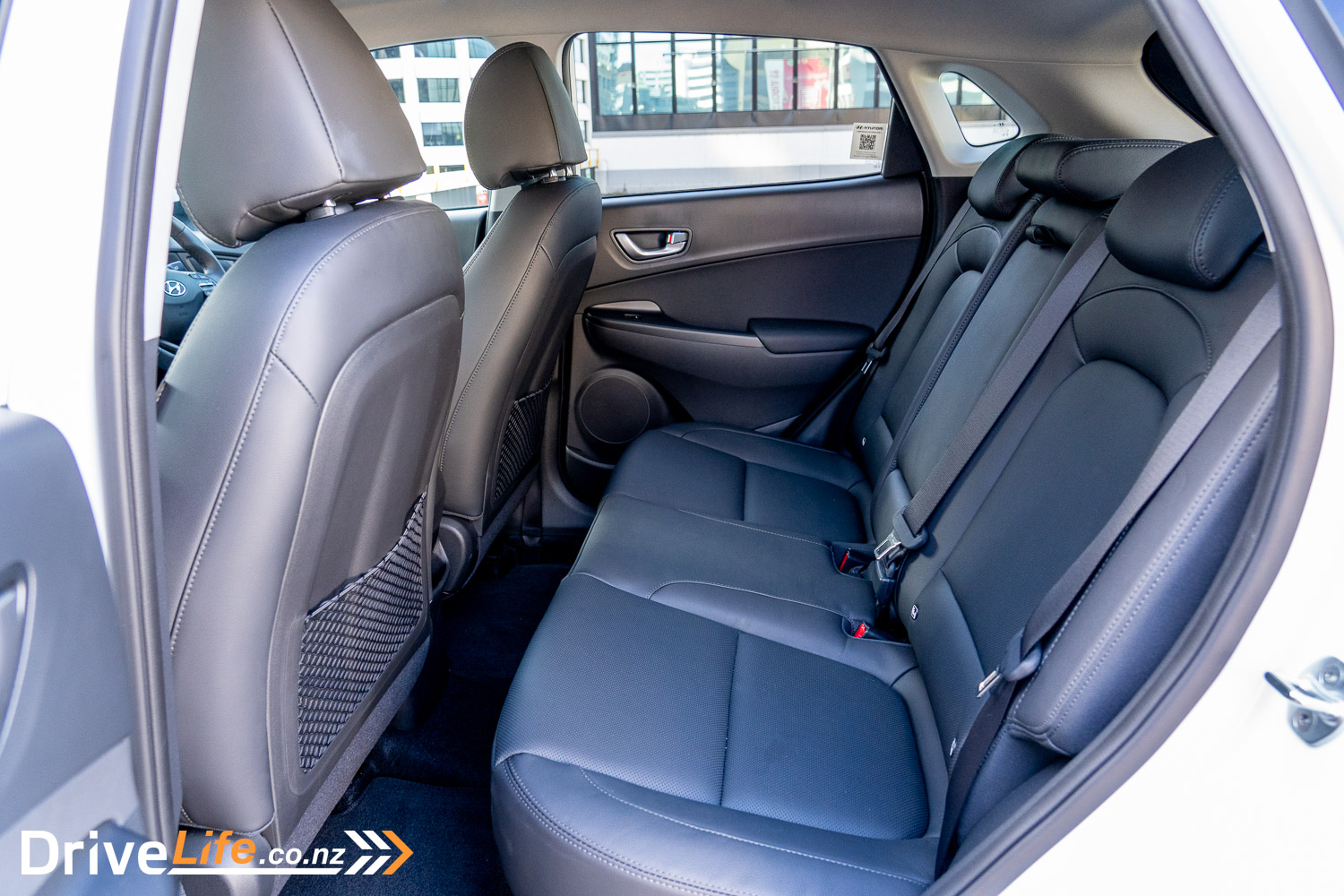
Adaptive cruise control is a one-button affair; just hit the button on the steering wheel, and your speed is set. So easy. It’s a stop/go system too, so with New Zealand’s crazy motorway system of traffic lights on a motorway, the car will bring itself to a stop (as long as there is a car in front of you) and when the traffic has moved off, the driver taps the ‘up’ button again, or taps the gas pedal, and the car will move off, back under the control of adaptive cruise. If you are distracted by something and do not notice the car in front has moved off, the Kona will let you know via a beep and a “lead car has moved off” message on the dash.
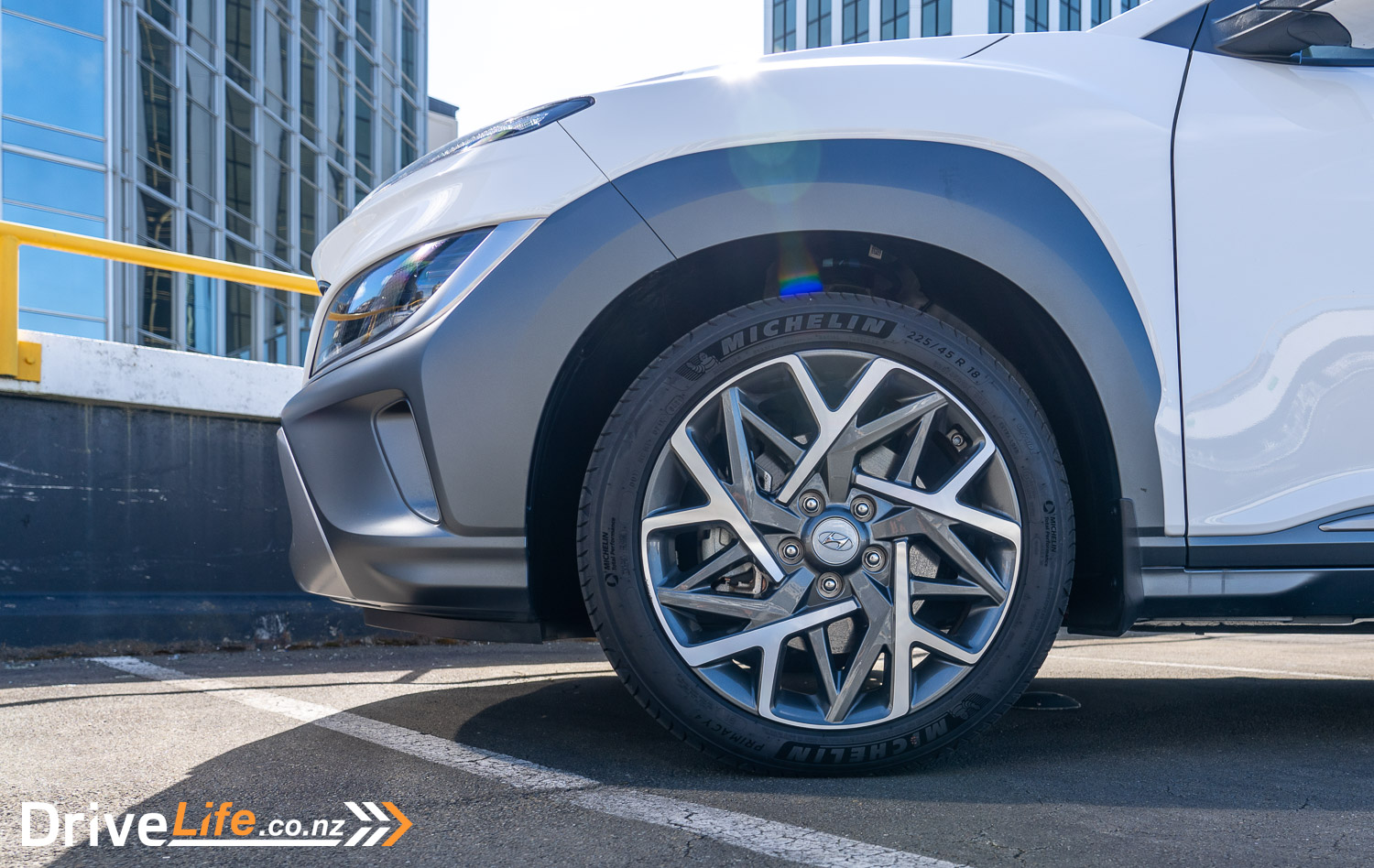
This all helps to make the 2022 Hyundai Kona Hybrid Elite a great commuter. Another feature helping the commute is the Lane Following Assist (LFA) button on the steering wheel. This will assist you with steering inputs by keeping your car in its lane, reducing driver fatigue. It was a mixed bag with this feature. Most of the time it would do a great job of assisting with steering the car, but sometimes if I let it show me how good it was, it would veer to one side of the lane and hit the cat’s eyes, then the car would beep at me to let me know I (it) had wandered out of my lane. So it’s a good feature however not one you should rely on – keeping in mind you are expected to be holding the steering wheel at all times.
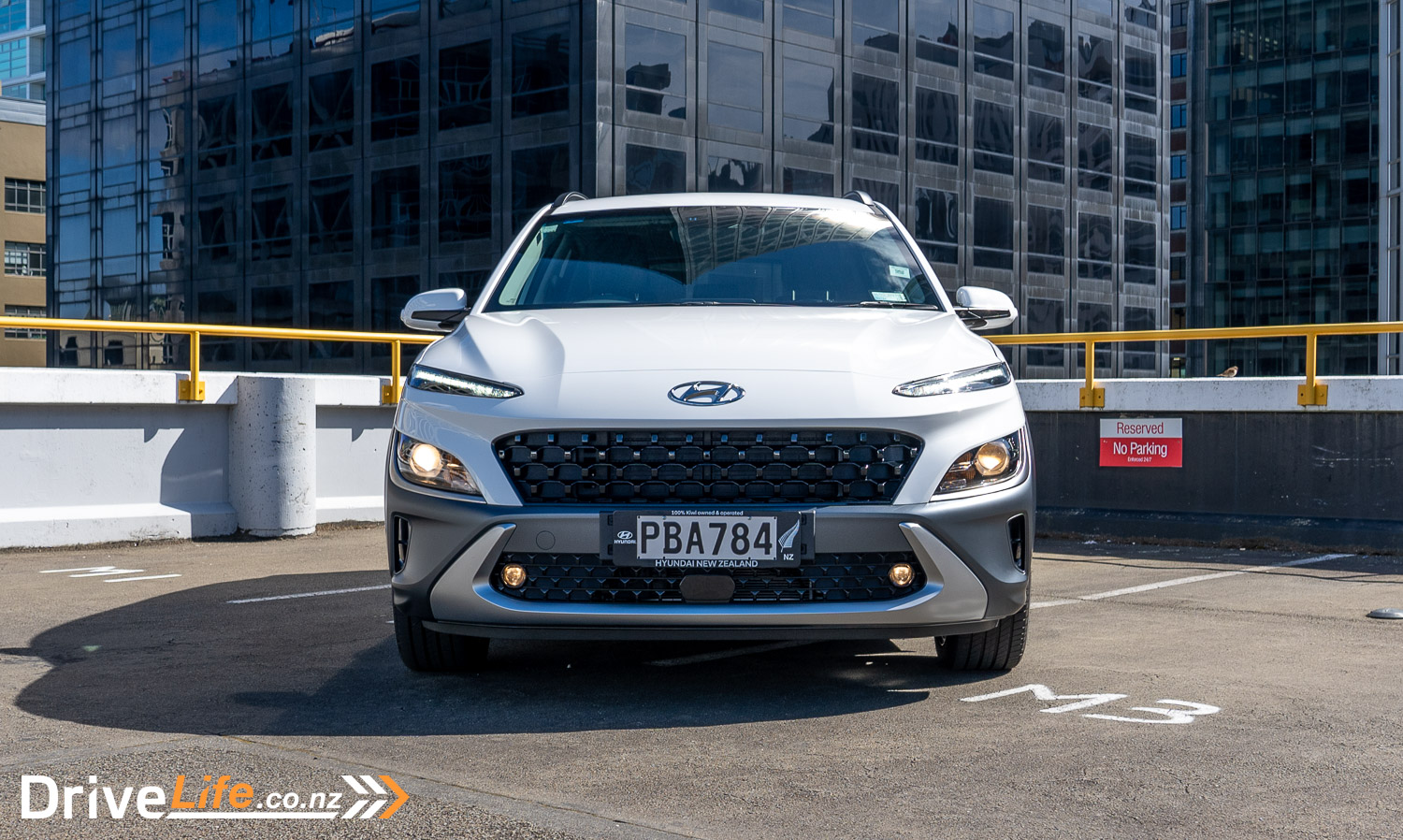
My first drive on my commute was 58Km and this was a mix of suburban, city and then motorway driving to my end location. On that first leg, the car returned 4.9L/100Km. With a majority of that drive on the motorway, that was about the number I was expecting.
Later in the week, as I drove into Paraparaumu on that daily commute, I pulled into the gas station with 6Km left in the tank. Yep, I like to live dangerously. My total distance travelled so far was 581Km (so I didn’t make the 745Km range after all) and fuel consumption of 5.0L/100Km.
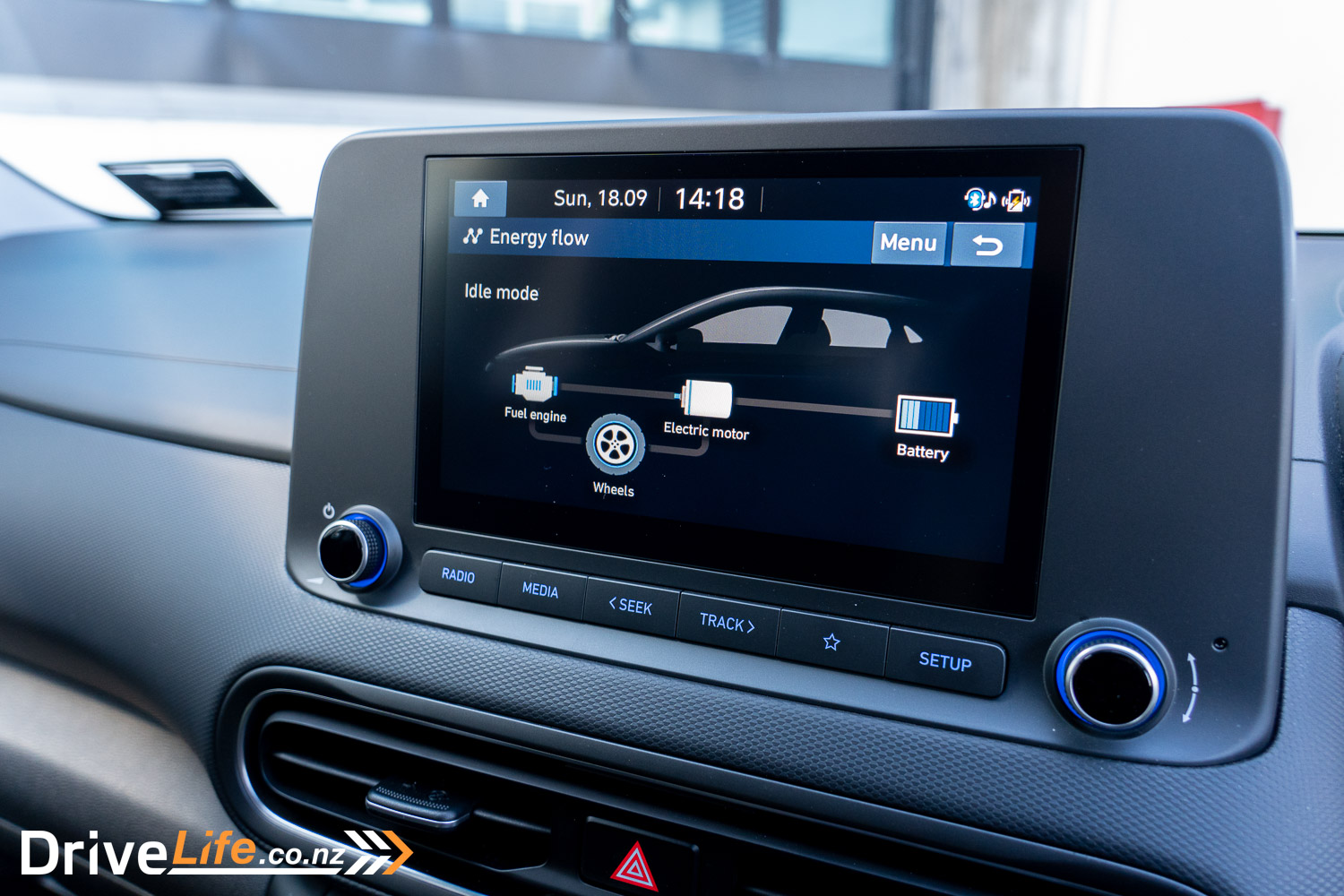
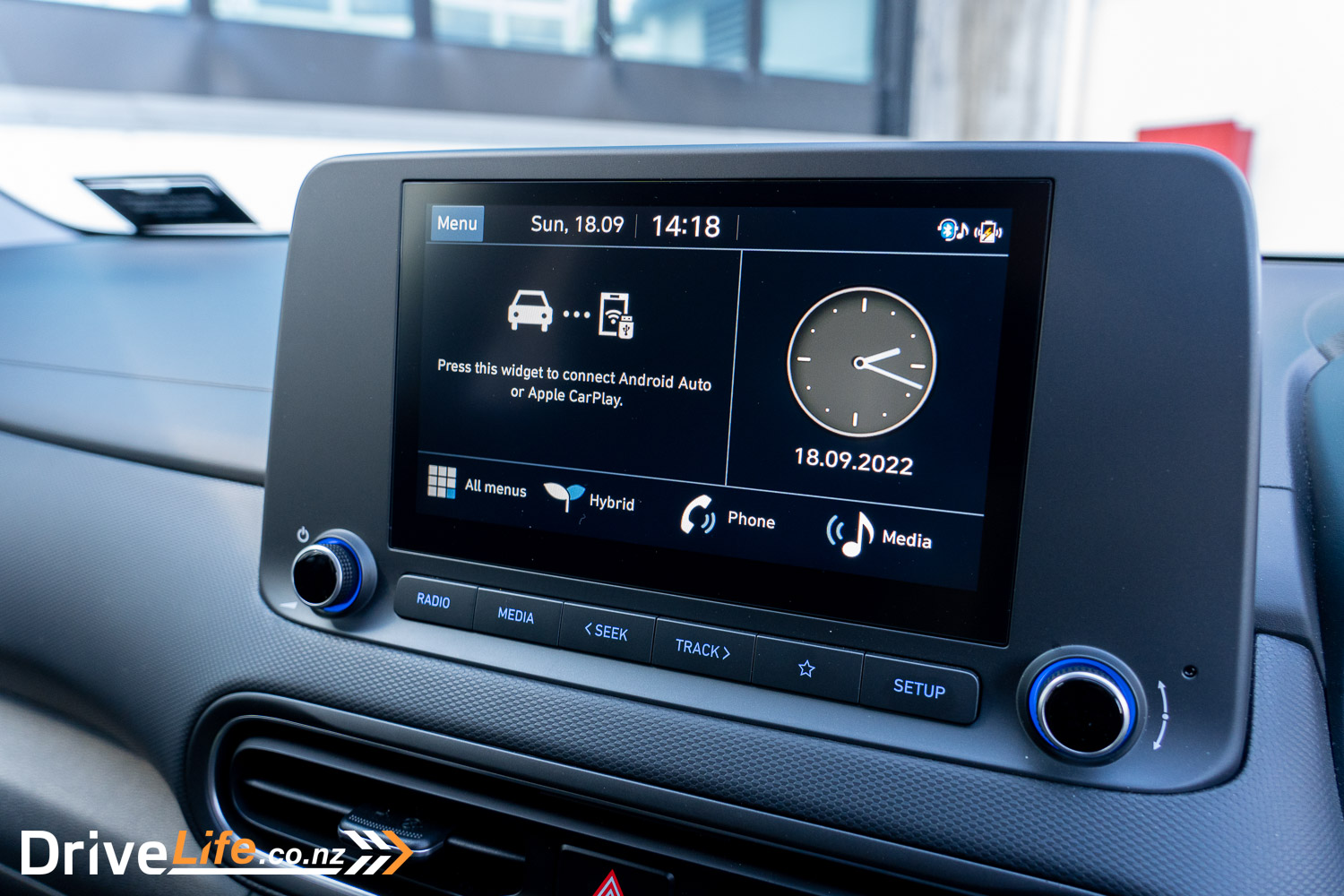
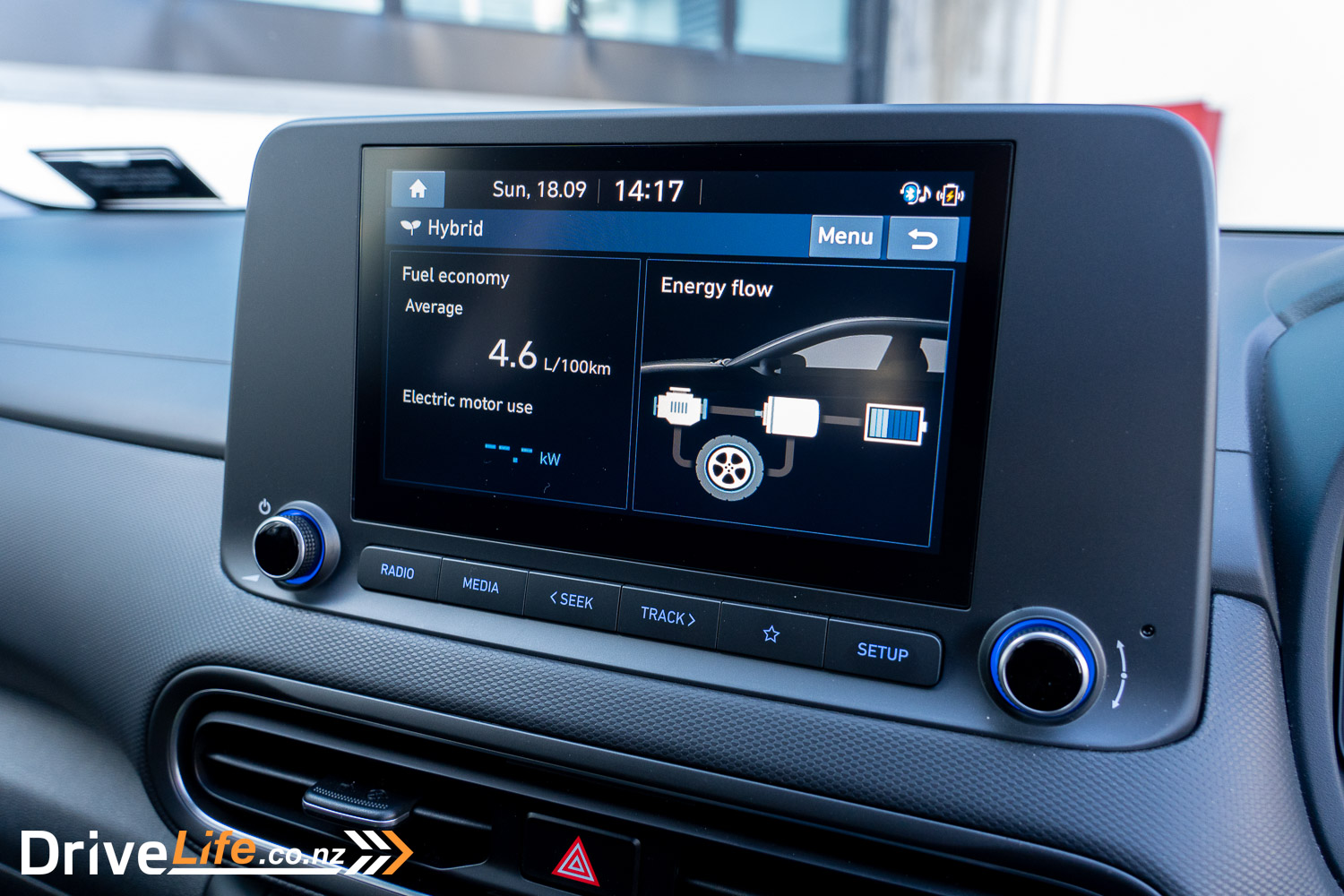
After a week’s commuting and general driving, I covered a total of 700Km in the 2022 Hyundai Kona Hybrid Elite. The result for fuel consumption was 5.1L/100Km, not much higher than the 4.4L/100Km that Hyundai suggests. While for some this might not seem particularly low, it compares favourably with other hybrids we’ve driven, like the 7.8L/100Km that Alistair got from the Mazda MX-30 and the 4.5L/100Km I got from the Honda Jazz e:HEV Luxe.
When Rob tested the Kona Elite (but not the hybrid), he got 6.2L/100Km out of it, so the hybrid model saved 1.1L/100Km, or around a cup of coffee’s worth of fuel per 100Km driven. So while the result for our test car compares with other hybrid tests, the actual saving isn’t that great, especially when you take into account the $15,000 premium over the $39,990 ICE Kona Elite. Still, that doesn’t take into account the lower emissions of the hybrid version. There’s also the Clean Car Programme rebate of $3,418 to take off the total cost and hopefully reduce some of the extra-cost pain.
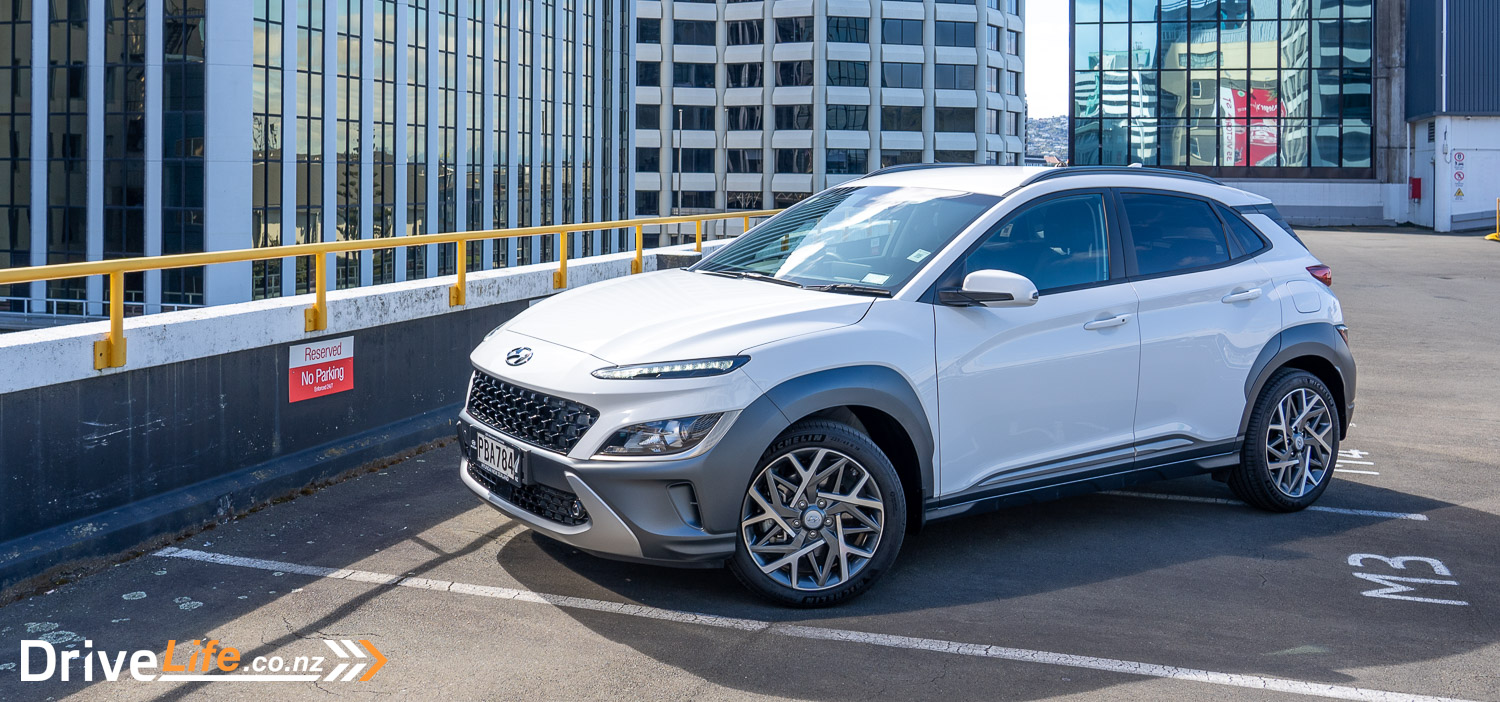
2022 Hyundai Kona Hybrid Elite – Specifications
| Vehicle Type | 5-door, small, front-wheel-drive hybrid SUV |
| Starting Price | $54,990 |
| Price as Tested | $54,990 |
| Engine | 1.6 litre 16 valve twin overhead cam with CVVT (Continuously Variable Valve Timing) & hybrid system (32kW/170Nm electric motor) |
| Power, Torque kW/Nm | Engine: 77kW@5,700rpm, 147NM@4,000rpm Combined with Hybrid System: 104kW, 265Nm |
| Transmission | 6-speed Dual Clutch Transmission (DCT) |
| Spare Wheel | Pump only |
| Kerb Weight, Kg | 1,376 |
| Length x Width x Height mm | 4205x1800x1565 |
| Boot Space / Cargo Capacity, Litres (seats up/seats down) | 374/1,156 |
| Fuel tank capacity, litres | 38 |
| Fuel Economy, L/100km | Advertised Spec – Combined – 4.4 Real-World Test – Combined – 5.1 Low Usage: 0-6 / Medium Usage 6-12 / High Usage 12+ |
| Towing Capacity Kg, unbraked/braked | 600/1,300 |
| Turning circle metres | 10.4 Small: 6-10m / Medium 10-12m / Large 12m+ |
| Warranty | 10 year/200,000 km anti-perforation corrosion body warranty 3 year/100,000 km mechanical warranty 3 year/100,000 km roadside assistance package 8 year/160,000 km high voltage battery warranty |
| Safety information | ANCAP Rating – 5 stars – Link Rightcar.govt.nz – 5 Stars – PBA784 |
Have you enjoyed this review? Be sure to join our monthly email newsletter list so you don’t miss a single car review!


